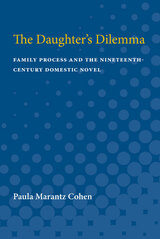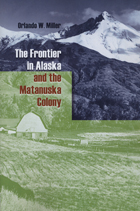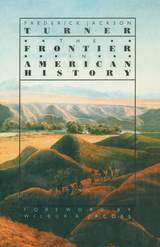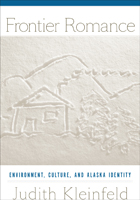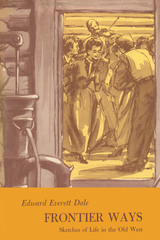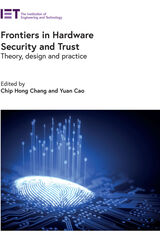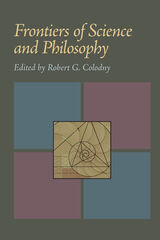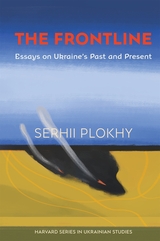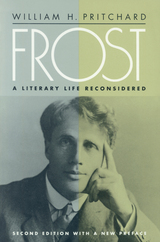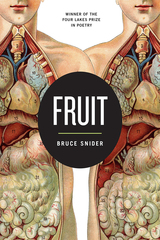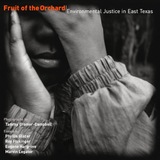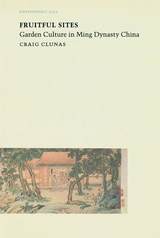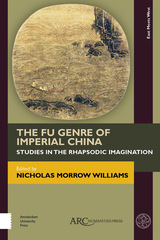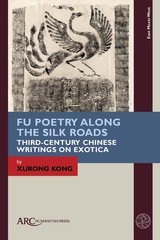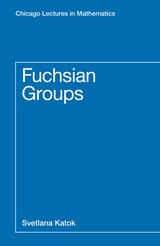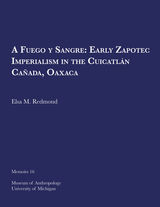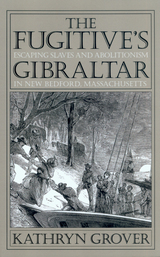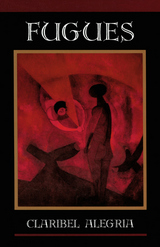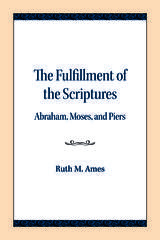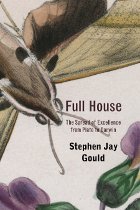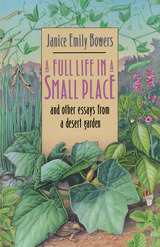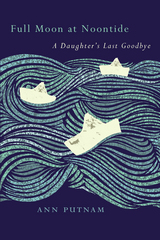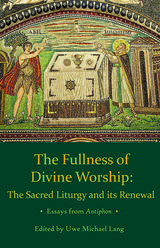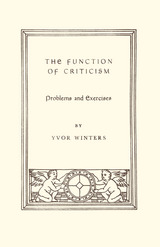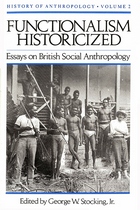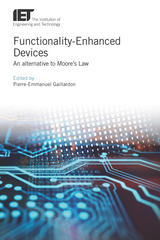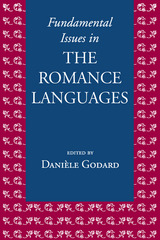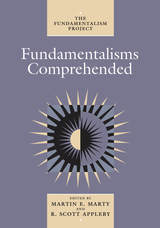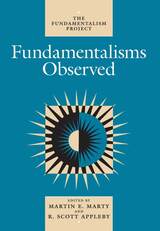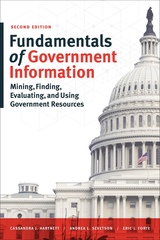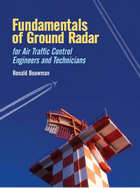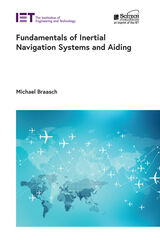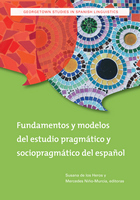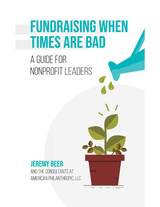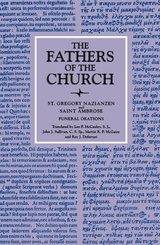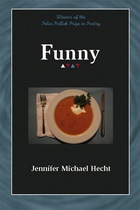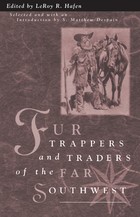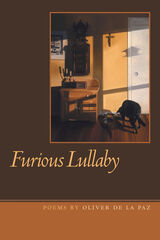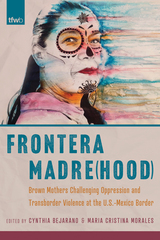 Frontera Madre(hood): Brown Mothers Challenging Oppression and Transborder Violence at the U.S.-Mexico Border
Edited by Cynthia Bejarano and Maria Cristina Morales
University of Arizona Press, 2024 The topic of mothers and mothering transcends all spaces, from popular culture to intellectual thought and critique. This collection of essays bridges both methodological and theoretical frameworks to explore forms of mothering that challenge hegemonic understandings of parenting and traditional notions of Latinx womxnhood. It articulates the collective experiences of Latinx, Black, and Indigenous mothering from both sides of the U.S.-Mexico border.
Thirty contributors discuss their lived experiences, research, or community work challenging multiple layers of oppression, including militarization of the border, border security propaganda, feminicides, drug war and colonial violence, grieving and loss of a child, challenges and forms of resistance by Indigenous mothers, working mothers in maquiladoras, queer mothering, academia and motherhood, and institutional barriers by government systems to access affordable health care and environmental justice. Also central to this collection are questions on how migration and detention restructure forms of mothering. Overall, this collection encapsulates how mothering is shaped by the geopolitics of border zones, which also transcends biological, sociological, or cultural and gendered tropes regarding ideas of motherhood, who can mother, and what mothering personifies.
Contributors
Elva M. Arredondo
Cynthia Bejarano
Bertha A. Bermúdez Tapia
Margaret Brown Vega
Macrina Cárdenas Montaño
Claudia Yolanda Casillas
Luz Estela (Lucha) Castro
Marisa Elena Duarte
Taide Elena
Sylvia Fernández Quintanilla
Paula Flores Bonilla
Judith Flores Carmona
Sandra Gutiérrez
Ma. Eugenia Hernández Sánchez
Irene Lara
Leticia López Manzano
Mariana Martinez
Maria Cristina Morales
Paola Isabel Nava Gonzales
Olga Odgers-Ortiz
Priscilla Pérez
Silvia Quintanilla Moreno
Cirila Quintero Ramírez
Felicia Rangel-Samponaro
Coda Rayo-Garza
Shamma Rayo-Gutierrez
Marisol Rodríguez Sosa
Brenda Rubio
Ariana Saludares
Victoria M. Telles
Michelle Téllez
Marisa S. Torres
Edith Treviño Espinosa
Mariela Vásquez Tobon
Hilda Villegas
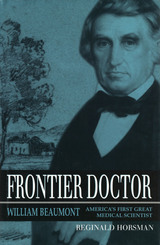 Frontier Doctor: William Beaumont, America's First Great Medical Scientist
Reginald Horsman
University of Missouri Press, 1996
In Frontier Doctor, Reginald Horsman provides the first modern, scholarly biography of a colorful backwoods doctor whose pioneering research on human digestion gained him international renown as a physiologist. Before William Beaumont's work, there was still considerable controversy as to the nature of human digestion; his research established beyond a doubt that digestion is a chemical process.
Beaumont received his medical training as an apprentice in a small town in Vermont and served as a surgeon's mate in the War of 1812. After the war, he practiced in Plattsburgh, New York, before making his career as an army surgeon. His chance for fame came in 1822, when he was serving at the lonely post of Fort Mackinac in Michigan Territory. A Canadian voyageur--Alexis St. Martin--was accidentally shot in the stomach at close range, and his wound healed in such a way as to leave a permanent opening. This enabled Beaumont to insert food directly into the stomach, to siphon gastric juice, and to experiment on the process of digestion both inside and outside the stomach.
Because Beaumont had considerable difficulty in persuading St. Martin to stay with him so he could continue his research, his study was carried out sporadically over a number of years. In the early 1830s, with the support of Joseph Lovell, the surgeon general of the army, Beaumont and St. Martin went to the East Coast, where additional experiments were carried out. In 1833, Beaumont published Experiments and Observations on the Gastric Juice and the Physiology of Digestion, a book based upon his research on St. Martin and the work upon which his reputation primarily rests. His observations revealed more about digestion in the human stomach than had ever before been known, and his work was immediately praised in both the United States and Europe.
After he left the army, Beaumont established a successful private practice in St. Louis, Missouri, where he spent the latter part of his life. Beaumont, a fascinating, argumentative character, was often engaged in public controversy. He was also good friends with several notable men, including the young Robert E. Lee.
Frontier Doctor sheds welcome new light on the state of medicine both inside and outside the army in the early nineteenth century and provides absorbing information on the early experi-ments that set the research into human digestion irrevocably on the right course.
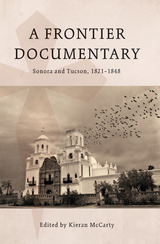 A Frontier Documentary: Sonora and Tucson, 1821–1848
Edited by Kieran McCarty
University of Arizona Press, 1997 When Mexico won its independence from Spain in 1821, citizens and missionaries in the northwestern reaches of the new nation were without the protection of Spanish military forces for the first time. Beset by hostile Apaches and the uncertainties of life in a desert wilderness, these early Mexican families forged a way of life that continues into the present day. This era in the history of southern Arizona and northern Sonora is now recalled in a series of historical documents that offer eyewitness accounts of daily life in the missions and towns of the region.
These documents give a sense of immediacy to the military operations, Indian activities, and missionary work going on in Tucson and the surrounding areas. They also demonstrate that Hispanic families maintained continuity in military and political control on the frontier, and clearly show that the frontier was not beset by anarchy in spite of the change in national government. In the forty chapters of translated documents in this collection, the voices of those who lived in what is now the Arizona-Sonora border region provide firsthand accounts of the people and events that shaped their era. These documents record such events as the arrival of the first Americans, the reconstruction of Tucson’s presidio wall, and conflict between Tohono O’odham villagers and Mexicans. All are set against the backdrop of an unrelenting Apache offensive that heightened after the departure of the Spanish military but that was held in check by civilian militias. Each chapter begins with a brief introduction in which historian Kieran McCarty provides background on the documents’ context and authorship. Taken together, they offer a fascinating look at this little-known period and provide a unique panorama of southwestern history.
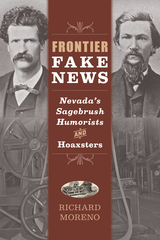 Frontier Fake News: Nevada's Sagebrush Humorists and Hoaxsters
Richard Moreno
University of Nevada Press, 2023 When readers see the names Mark Twain and Dan De Quille, fake news may not be the first thing that comes to mind. But these legendary journalists were some of the original, and most prolific, fake news writers in the early years of Nevada’s history. Frontier Fake News puts a spotlight on the hoaxes, feuds, pranks, outright lies, witty writing, and other literary devices utilized by a number of the Silver State’s frontier newsmen from the mid-nineteenth through the early twentieth centuries. Often known collectively as the Sagebrush School, these journalists were opinionated, talented, and individualistic.
While Mark Twain (Samuel Clemens), who got his start at Virginia City’s Territorial Enterprise, and Dan De Quille (William Wright), who some felt was a better writer than Twain, are the most well-known members of the Sagebrush School, author Richard Moreno includes others such as Fred Hart, who concocted a fake social club and reported on its gatherings for Austin’s Reese River Reveille, and William Forbes, who enjoyed sprinkling clever puns with political undertones in his newspaper articles.
Moreno traces the beginnings of genuine fake news from founding father Benjamin Franklin’s “Supplement to the Boston Independent Chronicle, Number 705, March 1782,” a fake newspaper aimed at swaying British public opinion, to the fake news articles of New York and Baltimore papers in the early 1800s. But these examples are only a prelude to the amazing accounts of petrified men, freeze-inducing solar armor, magically magnetic rocks, blood-curdling massacres, and other nonsense stories that appeared in Nevada’s frontier newspapers and beyond.
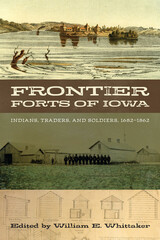 Frontier Forts of Iowa: Indians, Traders, and Soldiers, 1682-1862
William E. Whittaker
University of Iowa Press, 2009 At least fifty-six frontier forts once stood in, or within view of, what is now the state of Iowa. The earliest date to the 1680s, while the latest date to the Dakota uprising of 1862. Some were vast compounds housing hundreds of soldiers; others consisted of a few sheds built by a trader along a riverbank. Regardless of their size and function—William Whittaker and his contributors include any compound that was historically called a fort, whether stockaded or not, as well as all military installations—all sought to control and manipulate Indians to the advantage of European and American traders, governments, and settlers. Frontier Forts of Iowa draws extensively upon the archaeological and historical records to document this era of transformation from the seventeenth-century fur trade until almost all Indians had been removed from the region. The earliest European-constructed forts along the Mississippi, Des Moines, and Missouri rivers fostered a complex relationship between Indians and early traders. After the Louisiana Purchase of 1804, American military forts emerged in the Upper Midwest, defending the newly claimed territories from foreign armies, foreign traders, and foreign-supported Indians. After the War of 1812, new forts were built to control Indians until they could be moved out of the way of American settlers; forts of this period, which made extensive use of roads and trails, teamed a military presence with an Indian agent who negotiated treaties and regulated trade. The final phase of fort construction in Iowa occurred in response to the Spirit Lake massacre and the Dakota uprising; the complete removal of the Dakota in 1863 marked the end of frontier forts in a state now almost completely settled by Euro-Americans. By focusing on the archaeological evidence produced by many years of excavations and by supporting their words with a wealth of maps and illustrations, the authors uncover the past and connect it with the real history of real places. In so doing they illuminate the complicated and dramatic history of the Upper Midwest in a time of enormous change. Past is linked to present in the form of a section on visiting original and reconstructed forts today. Contributors: Gayle F. Carlson
Jeffrey T. Carr
Lance M. Foster
Kathryn E. M. Gourley
Marshall B. McKusick
Cindy L. Nagel
David J. Nolan
Cynthia L. Peterson
Leah D. Rogers
Regena Jo Schantz
Christopher M. Schoen
Vicki L. Twinde-Javner
William E. Whittaker
The Frontier in Alaska and the Matanuska Colony
Orlando W. Miller
University of Alaska Press, 2008 During the Great Depression, Franklin D. Roosevelt gave more than two hundred families from some of the poorest areas in Minnesota, Wisconsin, and Michigan the opportunity to start their farms anew in the undeveloped land of Matanuska in Alaska. These transplanted midwesterners soon found themselves in a startling new climate and landscape that presented many unexpected challenges. Available for the first time in paperback, The Frontier in Alaska and the Matanuska Colony examines several case studies of these original families, dispelling many frontier myths and describing the reality of pioneering in Alaska. Despite the many impediments, Orlando W. Miller argues, much of the current agricultural success in Matanuska can be directly credited to the innovative farmers who settled there in the 1930s.
The Frontier in American History
Frederick Jackson Turner
University of Arizona Press, 1986 Widely recognized as a classic of American historiography, The Frontier in American History examines the importance of the unsettled West as both idea and physical reality. Turner's essays explore the changing frontier as it moved progressively westward and discuss the contributions of the pioneers in each frontier area to the development of modern American democracy.
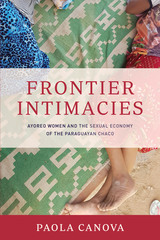 Frontier Intimacies: Ayoreo Women and the Sexual Economy of the Paraguayan Chaco
By Paola Canova
University of Texas Press, 2020 Until the 1960s, the Ayoreo people of Paraguay's Chaco region had remained uncontacted by the world. But as development encroached on their territory, the Ayoreo began to experience rapid cultural change. Paola Canova looks at one aspect of this change in Frontier Intimacies: the sexual practices of Ayoreo women, specifically the curajodie, or single women who exchange sex for money or material goods with non-Ayoreo men, often Mennonite settlers. Weaving personal anecdotes into her extensive research, Canova shows how the advancement of economic and missionary frontiers has reconfigured gender roles, sexual ethics, and notions of desire in the region. Ayoreo women, she shows, have reappropriated their sexual practices, approaching intimate liaisons on their own terms and seeing the involvement of money not as morally problematic but as constitutive of sexual encounters. By using their sexuality to construct an intimate frontier operating according to their own logics, Canova reveals, Ayoreo women expose the fractured workings of frontier capitalism in spaces of rapid transformation. Inviting broader examination of the ways in which contemporary frontier economies are constructed and experienced, Frontier Intimacies brings a captivating new perspective to the economic development of the Chaco region.
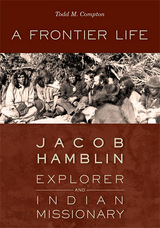 A Frontier Life: Jacob Hamblin, Explorer and Indian Missionary
Todd M. Compton
University of Utah Press, 2013 Winner of the Juanita Brooks Prize in Mormon Studies
Winner of the Evans Biography Award, the John Whitmer Historical Society Best Biography Award, and the Francis Armstrong Madsen Best Book Award
Frontiersman, colonizer, missionary to the Indians, and explorer of the American West, Jacob Hamblin has long been one of the most enigmatic figures in Mormon history. In this defining biography, Todd Compton examines and disentangles many of the myths and controversies surrounding Hamblin. His Grand Canyon adventures and explorations as a guide alongside John Wesley Powell are well documented, as are his roles as a missionary, cultural liaison, and negotiator to the Indian tribes of southern Utah and Arizona. Hamblin struggled in this latter role, sometimes unable to bridge the gulf between Mormonism and Indian culture. He disavowed violent conflict and ceaselessly sought peaceful resolutions where others resorted to punitive action. He strove above all for mutual understanding in the absence of conversion.
A Frontier Life provides a rich narrative that fleshes out a picture of a sometimes vilified figure, particularly in regard to his connection to the infamous Mountain Meadows Massacre, where Compton provides nuanced discussion clarifying Hamblin’s post-massacre role—he was not present at the massacre, but reported on it to both Brigham Young and military investigators. Compton’s engagement with Mormon historiography and previous Hamblin portrayals will make this work of particular interest to both scholars and students. The casual reader will take pleasure in learning of a true pioneer who lived life at the geographical, cultural, and spiritual boundaries of his era. This dramatic, entertaining biography is a truly significant contribution to Mormon history.
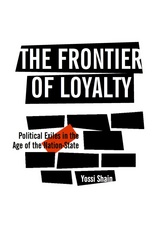 The Frontier of Loyalty: Political Exiles in the Age of the Nation-State
Yossi Shain
University of Michigan Press, 2005 Paperback edition of the pathbreaking book on the role of exiles in international relations, with a new foreword (including material on the war in Iraq).
"In a world increasingly shaped by transnational organizations and processes, this is a timely and welcome subject, and Yossi Shain provides an informative overview."
--Rogers Brubaker, Harvard University, in The American Journal of Sociology
"Engrossing."
--International Affairs
"Mr. Shain is at his best stitching together information that hitherto had not been systematically related to analytical themes. . . . A major contribution to understanding the patterns and complexities of the politics of those at home abroad."
--International Migration Review
"The Frontier of Loyalty is the first comprehensive and theoretically oriented study of exile politics; the types of exile activity; the relation to both the home and host governments; and the difficulties and ambiguities of exile politics, particularly the struggle for legitimacy as spokesman for the opposition at home and for recognition from the outside."
--- Juan J. Linz, Yale University
"An ingenious and sensitive analysis of political exiles as 'voice from without,' which contributes to our understanding of the transnational character of contemporary politics."
--- Aristide R. Zolberg, New School for Social Research
"Drawing upon a wide literature on contemporary political exiles, Yossi Shain presents a sophisticated, learned and sensible survey of their place in political life today. More important, his meditation on the role of exiles proves such essential political categories as legitimacy,
national loyalty, and opposition in the modern state. One test of any work of scholarship is whether it enhances our understanding of concepts that we have previously taken for granted. By this measure, Shain's book passes with flying colors."
--- Michael R. Marrus, University of Toronto
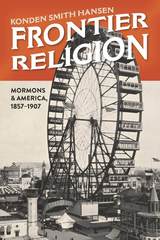 Frontier Religion: Mormons and America, 1857–1907
Konden Smith Hansen
University of Utah Press, 2019 At the 1893 Columbian Exposition in Chicago, Mormons were deliberately excluded from one of the main attractions, the Parliament of Religions. Organizers believed that Mormonism, with its connections to polygamy, did not merit a place alongside other world religions being showcased for the similar ways in which they inspired people to follow God. At the same time, however, Americans who had long shown hatred or distrust toward their Mormon neighbors had begun to see Mormonism in a different light. Underlying this new view of Mormonism was a rapidly developing belief in America’s fading western frontier as a place linked to core American values such as self-reliance, personal freedom, and democratic rule. With a unique history intimately tied to the frontier, Mormonism began to be seen less as something outside America, and more as a faith closely associated with the country’s most important principles.
In Frontier Religion Konden Smith Hansen examines the dramatic influence these perceptions of the frontier had on Mormonism and other religions in America. Endeavoring to better understand the sway of the frontier on religion in the United States, this book follows several Mormon-American conflicts, from the Utah War and the antipolygamy crusades to the Reed Smoot hearings. The story of Mormonism’s move toward American acceptability represents a larger story of the nation’s transition to modernity and the meaning of religious pluralism. This book challenges old assumptions and provokes further study of the ever changing dialectic between society and faith.
The Frontier Romance: Environment, Culture, and Alaska Identity
Judith Kleinfeld
University of Alaska Press, 2012 Anyone curious about what drew people like Christopher McCandless (the subject of Into the Wild) and John Muir to Alaska will find nuanced answers in Frontier Romance, Judith Kleinfeld’s thoughtful study of the iconic American love of the frontier and its cultural influence. Kleinfeld considers the subject through three catagories: rebellion, redemption, and rebirth; escape and healing; and utopian community. Within these categories she explores the power of narrative to shape lives through concrete, compelling examples—both heart-warming and horrifying. Ultimately, Kleinfeld argues that the frontier narrative enables Americans—born or immigrant—to live deliberately, to gather courage, and to take risks, face danger, and seize freedom rather than fear it.
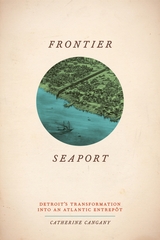 Frontier Seaport: Detroit's Transformation into an Atlantic Entrepôt
Catherine Cangany
University of Chicago Press, 2014 Detroit’s industrial health has long been crucial to the American economy. Today’s troubles notwithstanding, Detroit has experienced multiple periods of prosperity, particularly in the second half of the eighteenth century, when the city was the center of the thriving fur trade. Its proximity to the West as well as its access to the Great Lakes and the St. Lawrence River positioned this new metropolis at the intersection of the fur-rich frontier and the Atlantic trade routes.
In Frontier Seaport, Catherine Cangany details this seldom-discussed chapter of Detroit’s history. She argues that by the time of the American Revolution, Detroit functioned much like a coastal town as a result of the prosperous fur trade, serving as a critical link in a commercial chain that stretched all the way to Russia and China—thus opening Detroit’s shores for eastern merchants and other transplants. This influx of newcomers brought its own transatlantic networks and fed residents’ desires for popular culture and manufactured merchandise. Detroit began to be both a frontier town and seaport city—a mixed identity, Cangany argues, that hindered it from becoming a thoroughly “American” metropolis.
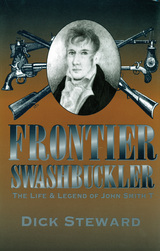 Frontier Swashbuckler: The Life and Legend of John Smith T
Dick Steward
University of Missouri Press, 2000 Few frontiersmen in the late eighteenth century and early nineteenth century epitomized the reckless energies of the West and the lust for adventure as did John Smith T—pioneer, gunfighter, entrepreneur, militia colonel, miner, judge, and folk hero. In this fascinating biography, Dick Steward traces the colorful Smith T's life from his early days in Virginia through his young adulthood. He then describes Smith T's remarkable career in the wilds of Missouri and his armed raids to gain land from Indians, Spaniards, and others. Born into the fifth generation of Virginia gentry, young Smith first made his name on the Tennessee frontier. It was there that he added the "T" to his name to distinguish his land titles and other enterprises from those of the hosts of other John Smiths. By the late 1790s he owned or laid claim to more than a quarter million acres in Tennessee and northern Alabama. In 1797, Smith T moved to Missouri, then a Spanish territory, and sought to gain control of its lead-mining district by displacing the most powerful American in the region, Moses Austin. He acquired such public positions as judge of the court of common pleas, commissioner of weights and levies, and lieutenant colonel of the militia, which enabled him to mount a spirited assault on Austin's virtual monopoly of the lead mines. Although neither side emerged a winner from that ten-year-old conflict, it was during this period that Smith T's fame as a gunfighter and duelist spread across the West. Known as the most dangerous man in Missouri, he was said to have killed fourteen men in duels. Smith T was also recognized by many for his good works. He donated land for churches and schools and was generous to the poor and downtrodden. He epitomized the opening of the West, helping to build towns, roads, and canals and organizing trading expeditions. Even though Smith T was one of the most notorious characters in Missouri history, by the late nineteenth century he had all but disappeared from the annals of western history. Frontier Swashbuckler seeks to rescue both the man and the legend from historical obscurity. At the same time, it provides valuable insights into the economic, political, and social dynamics of early Missouri frontier history.
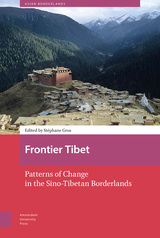 Frontier Tibet: Patterns of Change in the Sino-Tibetan Borderlands
Willem van Schendel
Amsterdam University Press, 2020 Frontier Tibet: Patterns of Change in the Sino-Tibetan Borderlands addresses a historical sequence that sealed the future of the Sino-Tibetan borderlands. It considers how starting in the late nineteenth century imperial formations and emerging nation-states developed competing schemes of integration and debated about where the border between China and Tibet should be. It also ponders the ways in which this border is internalised today, creating within the People’s Republic of China a space that retains some characteristics of a historical frontier. The region of eastern Tibet called Kham, the focus of this volume, is a productive lens through which processes of place-making and frontier dynamics can be analysed. Using historical records and ethnography, the authors challenge purely externalist approaches to convey a sense of Kham’s own centrality and the agency of the actors involved. They contribute to a history from below that is relevant to the history of China and Tibet, and of comparative value for borderland studies.
Frontier Ways: Sketches of Life in the Old West
By Edward Everett Dale
University of Texas Press, 1959 Edward Everett Dale gives a first-hand account of the way pioneer families and cowboys of the frontier lived. Dr. Dale has lived in a sod house, and he once rode the range as cook to a group of cowboys. In this book he draws on his varied experiences to describe all aspects of frontier life—the building of a home, the problems of finding wood and water, the procuring and cooking of food, medical practices, and the cultural, social, and religious life of pioneer families. This edition is a digital facsimile of the 1959 edition.
 Frontiers in Colorado Paleoindian Archaeology: From the Dent Site to the Rocky Mountains
Robert H. Brunswig
University Press of Colorado, 2007 As the Ice Age waned, Clovis hunter-gatherers began to explore and colonize the area now known as Colorado. Their descendents and later Paleoindian migrants spread throughout Colorado's plains and mountains, adapting to diverse landforms and the changing climate. In this new volume, Robert H. Brunswig and Bonnie L. Pitblado assemble experts in archaeology, paleoecology-climatology, and paleofaunal analysis to share new discoveries about these ancient people of Colorado. The editors introduce the research with scientific context. A review of seventy-five years of Paleoindian archaeology in Colorado highlights the foundation on which new work builds, and a survey of Colorado's ancient climates and ecologies helps readers understand Paleoindian settlement patterns. Eight essays discuss archaeological evidence from Plains to high Rocky Mountain sites. The book offers the most thorough analysis to date of Dent--the first Clovis site discovered. Essays on mountain sites show how advances in methodology and technology have allowed scholars to reconstruct settlement patterns and changing lifeways in this challenging environment. Colorado has been home to key moments in human settlement and in the scientific study of our ancient past. Readers interested in the peopling of the New World as well as those passionate about the methods and history of archaeology will find new material and satisfying overviews in this book. Contributors include Rosa Maria Albert, Robert H. Brunswig, Reid A. Bryson, Linda Scott Cummings, James Doerner, Daniel C. Fisher, David L. Fox, Bonnie L. Pitblado, Jeffrey L. Saunders, Todd A. Surovell, R. A. Varney, and Nicole M. Waguespack.
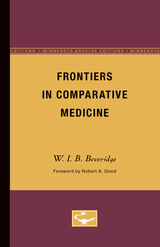 Frontiers in Comparative Medicine
W.I.B. Beveridge
University of Minnesota Press, 1972
Frontiers in Comparative Medicine was first published in 1972.In this initial volume of the series to be based on the Wesley W. Spink Lectures on Comparative Medicine, Dr. Beveridge, the noted British scientist, discusses the contributions to human medicine resulting from studies of disease in animals. The book serves as an excellent introduction to this important aspect of science, suitable for general readers as well as for those studying or working in the medical, biological, or social sciences.Dr. Beveridge examines the methodology of comparative science and tells of the remarkable series of key discoveries of disease agents which have emerged from research on animals. He explains the reasons for the success of animal studies in connection with human disease and makes a strong case for more research on naturally occurring animal models.The author describes current comparative studies in cancer, cardiovascular diseases, neuropathology, immunopathology, congenial defects, metal health, reproduction, and population regulation. He shows that in each of these subjects results that have far-reaching implications for human welfare and medicine are being obtained. In the final section he assembles the available evidence about the origin of human influenza pandemics. He points to a conclusion that they probably result from a hybridization of human and animal strains of the disease agent and that the usual place where this occurs appears to be the plains of Central Asia. He emphasizes the need for an international investigation of the problem of influenza, in the hope of preventing these pandemics.
Frontiers in Hardware Security and Trust: Theory, design and practice
Chip Hong Chang
The Institution of Engineering and Technology, 2021 Frontiers in Hardware Security and Trust provides a comprehensive review of emerging security threats and privacy protection issues, and the versatile state-of-the-art hardware-based security countermeasures and applications proposed by the hardware security community.
Frontiers in Securing IP Cores: Forensic detective control and obfuscation techniques
Anirban Sengupta
The Institution of Engineering and Technology, 2020 This book presents advanced forensic detective control and obfuscation techniques for securing hardware IP cores by exploring beyond conventional technologies. The theme is important to researchers in various areas of specialization, because it encompasses the overlapping topics of EDA-CAD, hardware design security, VLSI design, IP core protection, optimization using evolutionary computing, system-on-chip design and finally application specific processor/hardware accelerator design for consumer electronics applications.
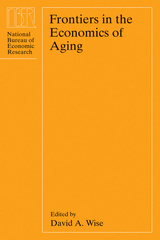 Frontiers in the Economics of Aging
Edited by David A. Wise
University of Chicago Press, 1998 As America's population ages, economic research related to the elderly becomes increasingly important to public policy.
Frontiers in the Economics in Aging directs attention to four topics: the role of retirement accounts, such as IRAs and 401(k)s in personal saving; the economics of health care; new advances in research methodology; and aging in relation to inequality. Some of the issues analyzed within these topics are the implications of rising personal retirement saving in recent years, how health and health insurance affect labor supply, and the effects of pensions on the distribution of wealth.
David Wise's lucid introduction provides an overview of each paper. In addition to this book's appeal for specialists and microeconomists, it offers immediately practical ideas and methods for shaping public policy. In fact, one of the papers in this volume, "The Taxation of Pensions: A Shelter Can Become a Trap," helped to spur new legislation that reformed laws on pension distribution.
 Frontiers of Astrophysics
Eugene H. Avrett
Harvard University Press One of the most vigorous sciences of our time, astrophysics constantly changes under the impact of new discoveries about everything from our own sun to the most distant and exotic of extragalactic phenomena. In chapters written especially for this volume, twelve distinguished scientists actively pursuing astrophysical research offer up-to-date reviews and commentary on new developments in their fields. With a little grounding in astronomy or physics, the reader will find this book an invaluable source of basic information on the most recent work in this field.
Frontiers of Astrophysics can be used as classroom reading, either as a main text or as supplementary reading in astronomy or physics courses, and it can be read with profit by anyone who wants current knowledge presented without complex mathematical arguments. Published within months after the contributions were written, this book is the most convenient and contemporary source on these topics: formation of the solar system (W.R. Ward); new developments in solar research (R. W. Noyes); early phases of stellar evolution (S.E. Storm); endpoints of stellar evolution (A.G.W. Cameron); neutron stars, black holes and supernocvae (H. Gursky); infrared astronomy (G.G. Fazio); gaseous nebulae and their interstellar environment (E.K. Chaisson); chemistry of the interstellar medium (A. Dalgarno); radio observations of galactic masers (J.M. Moran): active galaxies (K. Brecher); galaxies and cosmology (M. Davis); the mass of the universe and intergalactic matter (G.B. Field).
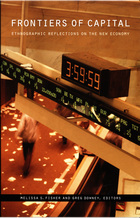 Frontiers of Capital: Ethnographic Reflections on the New Economy
Melissa S. Fisher and Greg Downey, eds.
Duke University Press, 2006 With the NASDAQ having lost 70 percent of its value, the giddy, optimistic belief in perpetual growth that accompanied the economic boom of the 1990s had fizzled by 2002. Yet the advances in information and communication technology, management and production techniques, and global integration that spurred the “New Economy” of the 1990s had triggered profound and lasting changes. Frontiers of Capital brings together ethnographies exploring how cultural practices and social relations have been altered by the radical economic and technological innovations of the New Economy. The contributors, most of whom are anthropologists, investigate changes in the practices and interactions of futures traders, Chinese entrepreneurs, residents of French housing projects, women working on Wall Street, cable television programmers, and others. Some contributors highlight how expedited flows of information allow business professionals to develop new knowledge practices. They analyze dynamics ranging from the decision-making processes of the Federal Reserve Board to the legal maneuvering necessary to buttress a nascent Japanese market in over-the-counter derivatives. Others focus on the social consequences of globalization and new modes of communication, evaluating the introduction of new information technologies into African communities and the collaborative practices of open-source computer programmers. Together the essays suggest that social relations, rather than becoming less relevant in the high-tech age, have become more important than ever. This finding dovetails with the thinking of many corporations, which increasingly employ anthropologists to study and explain the “local” cultural practices of their own workers and consumers. Frontiers of Capital signals the wide-ranging role of anthropology in explaining the social and cultural contours of the New Economy. Contributors. Jean Comaroff, John L. Comaroff, Greg Downey, Melissa S. Fisher, Douglas R. Holmes, George E. Marcus, Siobhán O’Mahony, Aihwa Ong, Annelise Riles, Saskia Sassen, Paul A. Silverstein, AbdouMaliq Simone, Neil Smith, Caitlin Zaloom
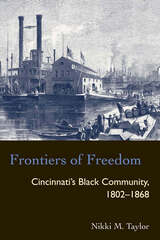 Frontiers of Freedom: Cincinnati’s Black Community 1802–1868
Nikki M. Taylor
Ohio University Press, 2004 Nineteenth-century Cincinnati was northern in its geography, southern in its economy and politics, and western in its commercial aspirations. While those identities presented a crossroad of opportunity for native whites and immigrants, African Americans endured economic repression and a denial of civil rights, compounded by extreme and frequent mob violence. No other northern city rivaled Cincinnati’s vicious mob spirit. Frontiers of Freedom follows the black community as it moved from alienation and vulnerability in the 1820s toward collective consciousness and, eventually, political self-respect and self-determination. As author Nikki M. Taylor points out, this was a community that at times supported all-black communities, armed self-defense, and separate, but independent, black schools. Black Cincinnati’s strategies to gain equality and citizenship were as dynamic as they were effective. When the black community united in armed defense of its homes and property during an 1841 mob attack, it demonstrated that it was no longer willing to be exiled from the city as it had been in 1829. Frontiers of Freedom chronicles alternating moments of triumph and tribulation, of pride and pain; but more than anything, it chronicles the resilience of the black community in a particularly difficult urban context at a defining moment in American history.
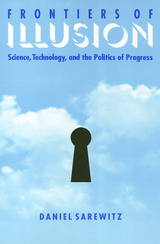 Frontiers Of Illusion: Science, Technology, and the Politics of Progress
Daniel Sarewitz
Temple University Press, 1996 For the past fifty years, science and technology—supported with billions of dollars from the U.S. government—have advanced at a rate that would once have seemed miraculous, while society's problems have grown more intractable, complex, and diverse. Yet scientists and politicians alike continue to prescribe more science and more technology to cure such afflictions as global climate change, natural resource depletion, overpopulation, inadequate health care, weapons proliferation, and economic inequality. Daniel Sarewitz scrutinizes the fundamental myths that have guided the formulation of science policy for half a century—myths that serve the professional and political interests of the scientific community, but often fail to advance the interests of society as a whole. His analysis ultimately demonstrates that stronger linkages between progress in science and progress in society will require research agendas that emerge not from the intellectual momentum of science, but from the needs and goals of society.
 Frontiers of Justice: Disability, Nationality, Species Membership
Martha C. Nussbaum
Harvard University Press, 2006 Theories of social justice are necessarily abstract, reaching beyond the particular and the immediate to the general and the timeless. Yet such theories, addressing the world and its problems, must respond to the real and changing dilemmas of the day. A brilliant work of practical philosophy, Frontiers of Justice is dedicated to this proposition. Taking up three urgent problems of social justice neglected by current theories and thus harder to tackle in practical terms and everyday life, Martha Nussbaum seeks a theory of social justice that can guide us to a richer, more responsive approach to social cooperation.
The idea of the social contract--especially as developed in the work of John Rawls--is one of the most powerful approaches to social justice in the Western tradition. But as Nussbaum demonstrates, even Rawls's theory, suggesting a contract for mutual advantage among approximate equals, cannot address questions of social justice posed by unequal parties. How, for instance, can we extend the equal rights of citizenship--education, health care, political rights and liberties--to those with physical and mental disabilities? How can we extend justice and dignified life conditions to all citizens of the world? And how, finally, can we bring our treatment of nonhuman animals into our notions of social justice? Exploring the limitations of the social contract in these three areas, Nussbaum devises an alternative theory based on the idea of "capabilities." She helps us to think more clearly about the purposes of political cooperation and the nature of political principles--and to look to a future of greater justice for all.
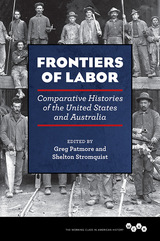 Frontiers of Labor: Comparative Histories of the United States and Australia
Edited by Greg Patmore and Shelton Stromquist
University of Illinois Press, 2018 Alike in many aspects of their histories, Australia and the United States diverge in striking ways when it comes to their working classes, labor relations, and politics. Greg Patmore and Shelton Stromquist curate innovative essays that use transnational and comparative analysis to explore the two nations’ differences. The contributors examine five major areas: World War I’s impact on labor and socialist movements; the history of coerced labor; patterns of ethnic and class identification; forms of working-class collective action; and the struggles related to trade union democracy and independent working-class politics. Throughout, many essays highlight how hard-won transnational ties allowed Australians and Americans to influence each other’s trade union and political cultures. Contributors: Robin Archer, Nikola Balnave, James R. Barrett, Bradley Bowden, Verity Burgmann, Robert Cherny, Peter Clayworth, Tom Goyens, Dianne Hall, Benjamin Huf, Jennie Jeppesen, Marjorie A. Jerrard, Jeffrey A. Johnson, Diane Kirkby, Elizabeth Malcolm, Patrick O’Leary, Greg Patmore, Scott Stephenson, Peta Stevenson-Clarke, Shelton Stromquist, and Nathan Wise
 Frontiers of Legal Theory
Richard A. Posner
Harvard University Press, 2004 The most exciting development in legal thinking since World War II has been the growth of interdisciplinary legal studies—the application of the social sciences and the humanities to law in the hope of making law less formalistic, more practical, better grounded empirically, bettered tailored to social goals. Judge Richard A. Posner has been a leader in this movement, and his new book explores its rapidly expanding frontier.
The book examines five principal areas or directions of interdisciplinary study: economics, history, psychology, the epistemology of law and the empirical study of law. These approaches are seen to interpenetrate and to compose a coherent body of legal theory—a unified framework for understanding such seemingly disparate phenomena as the economics of free speech, the intellectual history of economic analysis of law, the relation between income and liberty, the law of possession, the psychology of legal decisionmaking, the role of emotion in law, and the use of citation analysis to evaluate judges and law professors. The book carries on Posner’s project of analyzing the law as an institution of social governance.
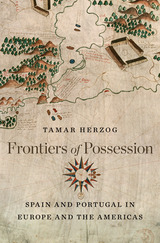 Frontiers of Possession: Spain and Portugal in Europe and the Americas
Tamar Herzog
Harvard University Press, 2015 Frontiers of Possession asks how territorial borders were established in Europe and the Americas during the early modern period and challenges the standard view that national boundaries are largely determined by military conflicts and treaties. Focusing on Spanish and Portuguese claims in the New and Old Worlds, Tamar Herzog reconstructs the different ways land rights were negotiated and enforced, sometimes violently, among people who remembered old possessions or envisioned new ones: farmers and nobles, clergymen and missionaries, settlers and indigenous peoples.
Questioning the habitual narrative that sees the Americas as a logical extension of the Old World, Herzog portrays Spain and Portugal on both sides of the Atlantic as one unified imperial space. She begins in the Americas, where Iberian conquerors had to decide who could settle the land, who could harvest fruit and cut timber, and who had river rights for travel and trade. The presence of indigenous peoples as enemies to vanquish or allies to befriend, along with the vastness of the land, complicated the picture, as did the promise of unlimited wealth. In Europe, meanwhile, the formation and re-formation of boundaries could last centuries, as ancient entitlements clashed with evolving economic conditions and changing political views and juridical doctrines regarding how land could be acquired and maintained.
Herzog demonstrates that the same fundamental questions had to be addressed in Europe and in the Americas. Territorial control was always subject to negotiation, as neighbors and outsiders, in their quotidian interactions, carved out and defended new frontiers of possession.
Frontiers of Science and Philosophy
Robert G. Colodny
University of Pittsburgh Press, 1963 Six essays by noted philosophers of science include the following topics: explanation in science and in history; philosophy and the scientific image of man; psychoanalysis and parapsychology; the conceptual basis of the biological sciences; the nature of time; and problems of microphysics.
Frontiers of Screen History: Imagining European Borders in Cinema, 1945-2010
Edited by Raita Merivirta, Kimmo Ahonen, Heta Mulari, and Rami Mähkä
Intellect Books, 2013 Frontiers of Screen History provides an insightful exploration into the depiction and imagination of European borders in cinema after World War II. While films have explored national and political borders, they have also attempted to identify, challenge, and imagine frontiers of another kind: social, ethnic, religious, and gendered. The book investigates all these perspectives. Its unique focus on the representation of European borders and frontiers via film is groundbreaking, opening up a new field of research and scholarly discussion. The exceptional variety of national and cultural perspectives provides a rewarding investigation of borders and frontiers.
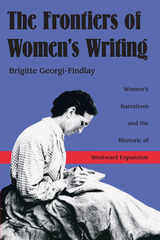 The Frontiers of Women's Writing: Women's Narratives and the Rhetoric of Westward Expansion
Brigitte Georgi-Findlay
University of Arizona Press, 1996 Although the myth of the American frontier is largely the product of writings by men, a substantial body of writings by women exists that casts the era of western expansion in a different light. In this study of American women's writings about the West between 1830 and 1930, a European scholar provides a reconstruction and new vision of frontier narrative from a perspective that has frequently been overlooked or taken for granted in discussions of the frontier.
Brigitte Georgi-Findlay presents a range of writings that reflects the diversity of the western experience. Beginning with the narratives of Caroline Kirkland and other women of the early frontier, she reviews the diaries of the overland trails; letters and journals of the wives of army officers during the Indian wars; professional writings, focusing largely on travel, by women such as Caroline Leighton from the regional publishing cultures that emerged in the Far West during the last quarter of the century; and late-nineteenth- and early-twentieth-century accounts of missionaries and teachers on Indian reservations. Most of the writers were white, literate women who asserted their own kind of cultural authority over the lands and people they encountered. Their accounts are not only set in relation to a masculine frontier myth but also investigated for clues about their own involvement with territorial expansion. By exploring the various ways in which women writers actively contributed to and at times rejected the development of a national narrative of territorial expansion based on empire building and colonization, the author shows how their accounts are implicated in expansionist processes at the same time that they formulate positions of innocence and detachment.
Georgi-Findlay has drawn on American studies scholarship, feminist criticism, and studies of colonial discourse to examine the strategies of women's representation in writing about the West in ways that most theorists have not. She critiques generally accepted stereotypes and assumptions--both about women's writing and its difference of view in particular, and about frontier discourse and the rhetoric of westward expansion in general--as she offers a significant contribution to literary studies of the West that will challenge scholars across a wide range of disciplines.
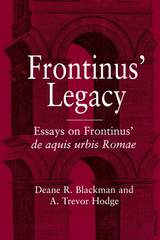 Frontinus' Legacy: Essays on Frontinus' de aquis urbis Romae
Deane R. Blackman and A. Trevor Hodge, Editors
University of Michigan Press, 2001 The city of Rome depended on a complex system of aqueducts for survival, and Frontinus purports to tell his readers how best to manage this system. Although his text is largely technical, his treatment of technicalities is not always clear, raising the question of how well he, and the Romans, really understood hydraulics.This interdisciplinary study of Frontinus' work addresses the questions that lie between the lines of his text. How large a work force was required to build an aqueduct, and how did they go about doing it? What did such an undertaking cost, and who was responsible for paying? Who decided which route should be followed? Why did Frontinus feel a need to write this book? Who was his audience? To date, Frontinus has been subjected to very little critical scrutiny. Deane R. Blackman and A. Trevor Hodge have gathered here a wide range of recognized authorities -- in classics, hydraulics engineering, surveying, financing, and the formation of calcium carbonate deposits in the water conduits -- to examine the puzzle Frontinus has left us.
The Frontline: Essays on Ukraine’s Past and Present
Serhii Plokhy
Harvard University Press, 2021 The Frontline presents a selection of essays drawn together for the first time to form a companion volume to Serhii Plokhy’s The Gates of Europe and Chernobyl. Here he expands upon his analysis in earlier works of key events in Ukrainian history, including Ukraine’s complex relations with Russia and the West, the burden of tragedies such as the Holodomor and World War II, the impact of the Chernobyl nuclear disaster, and Ukraine’s contribution to the collapse of the Soviet Union.
Juxtaposing Ukraine’s history to the contemporary politics of memory, this volume provides a multidimensional image of a country that continues to make headlines around the world. Eloquent in style and comprehensive in approach, the essays collected here reveal the roots of the ongoing political, cultural, and military conflict in Ukraine, the largest country in Europe.
The Frontline: Essays on Ukraine’s Past and Present
Serhii Plokhy
Harvard University Press, 2023 The Frontline presents a selection of essays drawn together for the first time to form a companion volume to Serhii Plokhy’s The Gates of Europe and Chernobyl. Here he expands upon his analysis in earlier works of key events in Ukrainian history, including Ukraine’s complex relations with Russia and the West, the burden of tragedies such as the Holodomor and World War II, the impact of the Chernobyl nuclear disaster, and Ukraine’s contribution to the collapse of the Soviet Union.
Juxtaposing Ukraine’s history to the contemporary politics of memory, this volume provides a multidimensional image of a country that continues to make headlines around the world. Eloquent in style and comprehensive in approach, the essays collected here reveal the roots of the ongoing political, cultural, and military conflict in Ukraine, the largest country in Europe.
 Fronto and Antonine Rome
Edward Champlin
Harvard University Press, 1980 This is a study of a man who was the presiding genius of Latin letters in the second century, the leading orator and lawyer of his day, a prominent senator and consul, the close friend of four emperors and the teacher of two, including the philosopher-emperor Marcus Aurelius. It is a history that tells as much about the age as the man.
The book begins in Roman North Africa, with an account of Fronto's family and education and the province's influence on his career. After a brief glance at his Italian milieu, Champlin examines Fronto's letters for what they reveal about Fronto and about literary life in the second century. Next come portrayals of Fronto as lawyer, as senator, and as courtier--chapters in Fronto's life that yield a full picture of Antonine society. A final chapter discusses what Marcus Aurelius learned from the orator.
The fragmentary nature of Fronto's letters has seriously hampered their use as a historical source. By close analysis of many of the letters and by the deployment of formidable prosopographical skills, Champlin has coaxed information out of this rich material, and he weaves it into a clear social history.
Front-Page Detective: William J. Burns and the Detective Profession, 1880–1930
William R. Hunt
University of Wisconsin Press, 1990 William J. Burns (1880-1930) was the immediate succor of J. Edgar Hoover at the Federal Bureau of Investigation. He had taken the director's job when Warren Harding was elected and appointed Burns' friend, Harry Daugherty, as Attorney General. Both Daugherty and Burns misused their offices and were forced to resign.
Front-Page Pittsburgh: Two Hundred Years Of The Post-Gazette
Clarke M. Thomas
University of Pittsburgh Press, 2005
Clarke Thomas has compiled a two-hundred-year history of the Pittsburgh Post-Gazette, the first paper published west of the Alleghenies. From the Whiskey Rebellion to the present, the stories the paper covered reveal the history of Pittsburgh and the people who live there.
Frost: A Literary Life Reconsidered
William H. Pritchard
University of Massachusetts Press, 1993 This study demonstrates the complex interaction between Frost's life and work. Based not only on the poetry, but on letters, notebooks, recorded interviews and public appearances as well, it treats the most significant aspects of Frost's life and poetry.
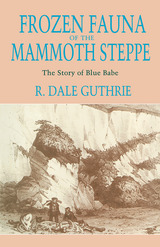 Frozen Fauna of the Mammoth Steppe: The Story of Blue Babe
R. Dale Guthrie
University of Chicago Press, 1990 Frozen mammals of the Ice Age, preserved for millennia in the tundra, have been a source of fascination and mystery since their first discovery over two centuries ago. These mummies, their ecology, and their preservation are the subject of this compelling book by paleontologist Dale Guthrie. The 1979 find of a frozen, extinct steppe bison in an Alaskan gold mine allowed him to undertake the first scientific excavation of an Ice Age mummy in North America and to test theories about these enigmatic frozen fauna.
The 36,000-year-old bison mummy, coated with blue mineral crystals, was dubbed "Blue Babe." Guthrie conveys the excitement of its excavation and shows how he made use of evidence from living animals, other Pleistocene mummies, Paleolithic art, and geological data. With photographs and scores of detailed drawings, he takes the reader through the excavation and subsequent detective work, analyzing the animal's carcass and its surroundings, the circumstances of its death, its appearance in life, the landscape it inhabited, and the processes of preservation by freezing. His examination shows that Blue Babe died in early winter, falling prey to lions that inhabited the Arctic during the Pleistocene era.
Guthrie uses information gleaned from his study of Blue Babe to provide a broad picture of bison evolutionary history and ecology, including speculations on the interactions of bison and Ice Age peoples. His description of the Mammoth Steppe as a cold, dry, grassy plain is based on an entirely new way of reading the fossil record.
Fruit
Bruce Snider
University of Wisconsin Press, 2020 Bruce Snider’s third poetry collection grapples with what it means to be childless in a world obsessed with procreation. Poems move between the scientific and the biblical, effortlessly sliding from the clinical landscape of a sperm bank to Mount Moriah as Abraham prepares Isaac for sacrifice. Exploring issues of sexuality, lineage, and mortality, Snider delves into subjects as varied as the Creation Museum in Petersburg, Kentucky; same-sex couple adoption; and Gregor Mendel’s death in 1884. Each poem builds into a broader examination of power and fragility, domesticity and rebellion, violence and devotion: heartrending vignettes of the aches and joys of growing up and testing the limits of nature and nurture. In language both probing and sensitive, Fruit delivers its own conflicted and celebratory answers to pressing questions of life, death, love, and biology.
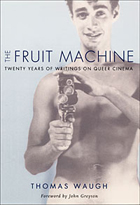 The Fruit Machine: Twenty Years of Writings on Queer Cinema
Thomas Waugh
Duke University Press, 2000 For more than twenty years, film critic, teacher, activist, and fan Thomas Waugh has been writing about queer movies. As a member of the Jump Cut collective and contributor to the Toronto-based gay newspaper the Body Politic, he emerged in the late 1970s as a pioneer in gay film theory and criticism, and over the next two decades solidified his reputation as one of the most important and influential gay film critics. The Fruit Machine—a collection of Waugh’s reviews and articles originally published in gay community tabloids, academic journals, and anthologies—charts the emergence and maturation of Waugh’s critical sensibilities while lending an important historical perspective to the growth of film theory and criticism as well as queer moviemaking.
In this wide-ranging anthology Waugh touches on some of the great films of the gay canon, from Taxi zum Klo to Kiss of the Spider Woman. He also discusses obscure guilty pleasures like Born a Man . . . Let Me Die a Woman, unexpectedly rich movies like Porky’s and Caligula, filmmakers such as Fassbinder and Eisenstein, and film personalities from Montgomery Clift to Patty Duke. Emerging from the gay liberation movement of the 1970s, Waugh traverses crises from censorship to AIDS, tackling mainstream potboilers along with art movies, documentaries, and avant-garde erotic videos. In these personal perspectives on the evolving cinematic landscape, his words oscillate from anger and passion to wry wit and irony. With fifty-nine rare film stills and personal photographs and an introduction by celebrated gay filmmaker John Greyson, this volume demonstrates that the movie camera has been the fruit machine par excellence.
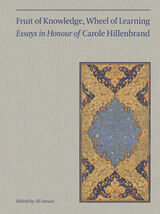 Fruit of Knowledge, Wheel of Learning (Vol I): Essays in Honour of Professor Carole Hillenbrand
Edited by Ali M. Ansari
Gingko, 2021 Collected essays honoring the work of British professors Carole and Robert Hillenbrand.
Carole and Robert Hillenbrand are legendary British professors, both of whom have made immense contributions to the fields of Islamic history and art history, and they are highly respected and beloved by the academic community. For these two volumes, editors Melanie Gibson and Ali Ansari have gathered an eclectic mix of scholarly contributions by colleagues and by some of their most recent students who now occupy positions in universities worldwide. The eleven articles in the volume dedicated to Carole Hillenbrand include research on a range of topics, including the elusive Fatimid caliph al-Zafir, a crusader raid on Mecca, and the Persian bureaucrat Mirza Saleh Shirazi’s history of England. In Robert Hillenbrand's volume, the thirteen articles include studies of a rare eighth-century metal dish with Nilotic scenes, Chinese Qur’ans, the process of image-making in both theory and practice, and a shrine in Mosul destroyed by ISIS.
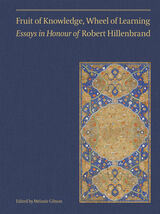 Fruit of Knowledge, Wheel of Learning (Vol II): Essays in Honour of Professor Robert Hillenbrand
Edited by Melanie Gibson
Gingko, 2021 Collected essays honoring the work of British professors Carole and Robert Hillenbrand.
Carole and Robert Hillenbrand are legendary British professors, both of whom have made immense contributions to the fields of Islamic history and art history, and they are highly respected and beloved by the academic community. For these two volumes, editors Melanie Gibson and Ali Ansari have gathered an eclectic mix of scholarly contributions by colleagues and by some of their most recent students who now occupy positions in universities worldwide. The eleven articles in the volume dedicated to Carole Hillenbrand include research on a range of topics, including the elusive Fatimid caliph al-Zafir, a crusader raid on Mecca, and the Persian bureaucrat Mirza Saleh Shirazi’s history of England. In Robert Hillenbrand's volume, the thirteen articles include studies of a rare eighth-century metal dish with Nilotic scenes, Chinese Qur’ans, the process of image-making in both theory and practice, and a shrine in Mosul destroyed by ISIS.
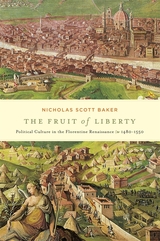 The Fruit of Liberty: Political Culture in the Florentine Renaissance, 1480-1550
Nicholas Scott Baker
Harvard University Press, 2013 In the middle decades of the sixteenth century, the republican city-state of Florence--birthplace of the Renaissance--failed. In its place the Medici family created a principality, becoming first dukes of Florence and then grand dukes of Tuscany. The Fruit of Liberty examines how this transition occurred from the perspective of the Florentine patricians who had dominated and controlled the republic. The book analyzes the long, slow social and cultural transformations that predated, accompanied, and facilitated the institutional shift from republic to principality, from citizen to subject.
More than a chronological narrative, this analysis covers a wide range of contributing factors to this transition, from attitudes toward office holding, clothing, and the patronage of artists and architects to notions of self, family, and gender. Using a wide variety of sources including private letters, diaries, and art works, Nicholas Baker explores how the language, images, and values of the republic were reconceptualized to aid the shift from citizen to subject. He argues that the creation of Medici principality did not occur by a radical break with the past but with the adoption and adaptation of the political culture of Renaissance republicanism.
 Fruit of the Month
Abby Frucht
University of Iowa Press, 1988 This fine debut of twelve stories explores a topography of the interior, probing the thoughts, motivations, and little-understood impulses behind moments of aggression, jealousy, and loneliness. Turning her eye on the academic landscape as well as the workaday world, Frucht keenly observes people forging friendships, groping for greater self-understanding, and attempting to find meaning in their lives and loves. Whether writing about a couple trying to conceive a much-wanted child or a lonely husband mourning the changing political attitudes of his wife, Frucht brings her characters and their lives into memorable focus. She builds a fictional world that resonates with the immediate and the familiar. Although many books of contemporary fiction document the ways people often fail to communicate, the essential quality of Abby Frucht's characters is that they do communicate—connect—and gain part of what they want from life as a result. These stories are never about despair without also being about hope. They speak to each other as playfully and accidentally as memories do.
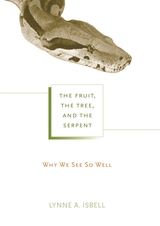 The Fruit, the Tree, and the Serpent: Why We See So Well
Lynne A. Isbell
Harvard University Press, 2009 From the temptation of Eve to the venomous murder of the mighty Thor, the serpent appears throughout time and cultures as a figure of mischief and misery. The worldwide prominence of snakes in religion, myth, and folklore underscores our deep connection to the serpent—but why, when so few of us have firsthand experience? The surprising answer, this book suggests, lies in the singular impact of snakes on primate evolution. Predation pressure from snakes, Lynne Isbell tells us, is ultimately responsible for the superior vision and large brains of primates—and for a critical aspect of human evolution.
Drawing on extensive research, Isbell further speculates how snakes could have influenced the development of a distinctively human behavior: our ability to point for the purpose of directing attention. A social activity (no one points when alone) dependent on fast and accurate localization, pointing would have reduced deadly snake bites among our hominin ancestors. It might have also figured in later human behavior: snakes, this book eloquently argues, may well have given bipedal hominins, already equipped with a non-human primate communication system, the evolutionary nudge to point to communicate for social good, a critical step toward the evolution of language, and all that followed.
 Fruitful Sites: Garden Culture in Ming Dynasty China
Craig Clunas
Duke University Press, 1996 Gardens are sites that can be at one and the same time admired works of art and valuable pieces of real estate. As the first account in English to be wholly based on contemporary Chinese sources, this innovative, beautifully illustrated book grounds the practices of garden-making in Ming dynasty China (1368–1644) firmly in the social and cultural history of the day.
Who owned Ming gardens? Who visited them? How were they represented in words, in paintings, and in visual culture generally, and what meanings did these representations hold at different levels of Chinese society? How did the discourse of gardens intersect with other discourses such as those of aesthetics, agronomy, geomancy, and botany? By examining the gardens of the city of Suzhou from a number of different angles, Craig Clunas provides a rich picture of a complex cultural phenomenon—one that was of crucial importance to the self-fashioning of the Ming elite.
Drawing on a wide range of recent work in cultural theory, the author provides for the first time a historical and materialist account of Chinese garden culture, and replaces broad generalizations and orientalist fantasy with a convincing picture of the garden’s role in social life. Fruitful Sites will appeal to all students of China’s cultural history, to students of garden history from any part of the world, to art historians, and to readers engaged in Asian and cultural studies.
Fruitful Sites: Garden Culture in Ming Dynasty China
Craig Clunas
Reaktion Books, 1996 Gardens are sites that can be at one and the same time admired works of art and valuable pieces of real estate. As the first account in English to be wholly based on contemporary Chinese sources, this beautifully illustrated book grounds the practices of garden-making in Ming Dynasty China (1369–1644) firmly in the social and cultural history of the day.
Who owned gardens? Who visited them? How were they represented in words, in paintings and in visual culture generally, and what meanings did these representations hold at different levels of Chinese society? Drawing on a wide range of recent work in cultural theory, Craig Clunas provides for the first time a historical and materialist account of Chinese garden culture, and replaces broad generalizations and orientalist fantasy with a convincing picture of the garden's role in social life.
 Fruits and Plains: The Horticultural Transformation of America
Philip J. Pauly
Harvard University Press, 2008 The engineering of plants has a long history on this continent. Fields, forests, orchards, and prairies are the result of repeated campaigns by amateurs, tradesmen, and scientists to introduce desirable plants, both American and foreign, while preventing growth of alien riff-raff. These horticulturists coaxed plants along in new environments and, through grafting and hybridizing, created new varieties. Over the last 250 years, their activities transformed the American landscape.
"Horticulture" may bring to mind white-glove garden clubs and genteel lectures about growing better roses. But Philip J. Pauly wants us to think of horticulturalists as pioneer "biotechnologists," hacking their plants to create a landscape that reflects their ambitions and ideals. Those standards have shaped the look of suburban neighborhoods, city parks, and the "native" produce available in our supermarkets.
In telling the histories of Concord grapes and Japanese cherry trees, the problem of the prairie and the war on the Medfly, Pauly hopes to provide a new understanding of not only how horticulture shaped the vegetation around us, but how it influenced our experiences of the native, the naturalized, and the alien--and how better to manage the landscapes around us.
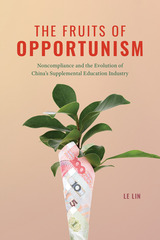 The Fruits of Opportunism: Noncompliance and the Evolution of China's Supplemental Education Industry
Le Lin
University of Chicago Press, 2022 An in-depth examination of the regulatory, entrepreneurial, and organizational factors contributing to the expansion and transformation of China’s supplemental education industry. Like many parents in the United States, parents in China, increasingly concerned with their children’s academic performance, are turning to for-profit tutoring businesses to help their children get ahead in school. China’s supplemental education industry is now the world’s largest and most vibrant for-profit education market, and we can see its influence on the US higher education system: more than 70% of Chinese students studying in American universities have taken test preparation classes for overseas standardized tests. The Fruits of Opportunism offers a much-needed thorough investigation into this industry. This book examines how opportunistic organizations thrived in an ambiguous policy environment and how they catalyzed organizational and institutional changes in this industry. A former insider in China’s Education Industry, sociologist Le Lin shows how and why this industry evolved to become a for-profit one dominated by private, formal, nationally operating, and globally financed corporations, despite restrictions the Chinese state placed on the industry. Looking closely at the opportunistic organizations that were founded by marginal entrepreneurs and quickly came to dominate the market, Lin finds that as their non-compliant practices spread across the industry, these opportunistic organizations pushed privatization and marketization from below. The case of China’s Education Industry laid out in The Fruits of Opportunism illustrates that while opportunism leaves destruction in its wake, it can also drive the formation and evolution of a market.
 Fruits of Propaganda in the Tyler Administration
Frederick Merk
Harvard University Press, 1971 Frederick Merk explores a little-known aspect of the Tyler administration—the use of the President’s secret fund, intended for foreign intercourse, to gain domestic support for his policy—and finds in this a key to the administration’s success. Of the frustrating Maine boundary dispute he has relied on evidence hitherto unexplored or inaccessible. On the subject of the annexation of Texas he has examined the role of government-directed propaganda in the conversion of public opinion, especially in the North, to the extension of slave territory. In regard to Tyler he has steered a middle course between the opinion on the one hand that the president was a mediocrity carried to his successes by abler men, and on the other that he was the real director of his foreign policy. The book is a significant contribution to the history of government-directed propaganda in the United States and to a better understanding of the Tyler administration.
Frustrated Empire: US Foreign Policy, 9/11 to Iraq
David Ryan
Pluto Press, 2007 David Ryan examines the broad contexts of US foreign policy and the lingering aftermath of the Vietnam War that shaped the opportunistic framing of 9/11 and paved the way for the long-held neo-conservative desire for regime change and war in Iraq. He explores the construction of the cultural framework for war following 9/11, the legitimacy of military force in Afghanistan, the rise of anti-Americanism, within the broader contexts of the struggle over legitimacy, identity and leadership. Turning the "clash of civilizations" thesis on its head, Ryan presents a careful analysis of the evolution of US foreign policy and its engagement with Iraq through the 1980s. While 9/11 provided the opportunity, the post-Vietnam context provides a more pertinent framework for this reflection on the Gulf War, the Iraq War and the strategic implications for US foreign policy.
The Fu Genre of Imperial China: Studies in the Rhapsodic Imagination
Nicholas Morrow Williams
Arc Humanities Press, 2019 This is the first book in English to examine the fu, one of China’s oldest and culturally central literary forms, from its origins up to the late imperial era. Fu poems are highly revealing sources for understanding the culture, society, and politics of their periods, and in this volume eleven essays by prominent scholars treat the fu from four major perspectives: its original use in court recitation; as a poetic genre with distinctive formal features; as a vehicle of philosophical inquiry; and as a major mode of political expression.
Fu Poetry Along the Silk Roads: Third-Century Chinese Writings on Exotica
Xurong Kong
Arc Humanities Press, 2022
This book explores the dissemination of ideas and information on the early silk roads between Europe and China, through the first detailed study of the Sinicization of foreign objects in Chinese poetic writing of the third century CE.
Third-century literary developments and the prevailing literary works from that era leave us with an impressive amount of information concerning exotic objects, such as plants, animals, and crafts, and record the cultural exchange between distant peoples whose goods, ideas, and technologies entered China.
These hitherto-forgotten rhapsodies express the profound interest and excitement of learned men for foreign objects. They bear witness to the cultural exchanges between China and other civilizations and provide a more nuanced insight of early medieval China as an integrated society rather than an isolated one.
 Fu Shan’s World: The Transformation of Chinese Calligraphy in the Seventeenth Century
Qianshen Bai
Harvard University Press, 2003 For 1,300 years, Chinese calligraphy was based on the elegant art of Wang Xizhi (A.D. 303–361). But the seventeenth-century emergence of a style modeled on the rough, broken epigraphs of ancient bronzes and stone artifacts brought a revolution in calligraphic taste. By the eighteenth century, this led to the formation of the stele school of calligraphy, which continues to shape Chinese calligraphy today.
A dominant force in this school was the eminent calligrapher and art theorist Fu Shan (1607–1685). Because his work spans the late Ming–early Qing divide, it is an ideal prism through which to view the transformation in calligraphy.
Rather than seek a single explanation for the change in calligraphic taste, the author demonstrates and analyzes the heterogeneity of the cultural, social, and political processes behind it. Among other subjects, the book covers the late Ming interaction between high and low culture; the role of publishing; the Ming loyalist response to the Qing; and early Qing changes in intellectual discourse. In addition to the usual approach of art historians, it adopts the theoretical perspectives of such fields as material culture, print culture, and social and intellectual history.
Fuchsia in Cambodia: Poems
Roy Jacobstein
Northwestern University Press, 2008 Suffused with tenderness and humor, the poems in this new collection take readers on a journey through emotions, across national boundaries, and even along the geographic timeline. The quick mind of author Jacobstein creates fluid verse that can take on the singular geography of his native Michigan or the story of an immigrant cab driver with ease. His elegant rhyme and clever rhythm are suited equally to an ode to the stegosaurus and to his many poems for his adopted daughter. He moves readers from Washington, D.C., to Delhi, from adolescence to fatherhood, and between heaven and earth. With its immersive voice and sensitive examinations, this set of verses retains its sense of wonder at all the beautiful hellos and good-byes that humans come to know well in their too-short lifetimes.
Fuchsian Groups
Svetlana Katok
University of Chicago Press, 1992 This introductory text provides a thoroughly modern treatment of Fuchsian groups that addresses both the classical material and recent developments in the field. A basic example of lattices in semisimple groups, Fuchsian groups have extensive connections to the theory of a single complex variable, number theory, algebraic and differential geometry, topology, Lie theory, representation theory, and group theory.
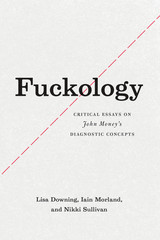 Fuckology: Critical Essays on John Money's Diagnostic Concepts
Lisa Downing, Iain Morland, and Nikki Sullivan
University of Chicago Press, 2014 One of the twentieth century’s most controversial sexologists—or “fuckologists,” to use his own memorable term—John Money was considered a trailblazing scientist and sexual libertarian by some, but damned by others as a fraud and a pervert. Money invented the concept of gender in the 1950s, yet fought its uptake by feminists. He backed surgical treatments for transsexuality, but argued that gender roles were set by reproductive capacity. He shaped the treatment of intersex, advocating experimental sex changes for children with ambiguous genitalia. He pioneered drug therapy for sex offenders, yet took an ambivalent stance towards pedophilia. In his most publicized case study, Money oversaw the reassignment of David Reimer as female following a circumcision accident in infancy. Heralded by many as proof that gender is pliable, the case was later discredited when Reimer revealed that he had lived as a male since his early teens.
In Fuckology, the authors contextualize and interrogate Money's writings and practices. The book focuses on his three key diagnostic concepts, “hermaphroditism,” “transsexualism,” and “paraphilia,” but also addresses his lesser-known work on topics ranging from animal behavior to the philosophy of science. The result is a comprehensive collection of new insights for researchers and students within cultural, historical, and gender studies, as well as for practitioners and activists in sexology, psychology, and patient rights.
A Fuego y Sangre: Early Zapotec Imperialism in the Cuicatlán Cañada, Oaxaca
Elsa M. Redmond
University of Michigan Press, 1983 In this volume, Elsa M. Redmond reconstructs the history of the Cuicatec region in Oaxaca, Mexico, from the Middle Formative period through the Lomas phase, when the Zapotec state based at Monte Albán took control, into the Trujano phase and the Spanish conquest. Redmond integrates archaeological data and sixteenth-century ethnohistoric records to inform her study of the political and social strategies of the Cuicatec region during these time periods. From 1977 to 1978, Redmond conducted an archaeological survey in this region, and she presents the results of that fieldwork here.
 Fuel: A Speculative Dictionary
Karen Pinkus
University of Minnesota Press, 2016 Fuel is an idiosyncratic, speculative dictionary of fuels, real and imagined, historical and futuristic, hopeless and utopian. Drawing on literature, film, and scientific treatises—most produced long before “climate change” was in circulation—Fuel argues for a distinction between energy (a system of power) and fuel (a substance, which can be thought of as “potentiality”) as it endeavors to undo the dream that we can simply switch to renewables and all will be golden. From “Air” to “Zyklon B,” entries in this unusual “dictionary” include Algae, Clathrates, Dilithium, Fleece, Goats, Theology, Whale Oil, and many, many more. The tone of the entries ranges as widely as the topics: from historical anecdotes (the Ford Fiesta “boozemobile”) to eccentric readings of the classics of “energy lit” (Germinal and Oil!); from literary observations (a high octane Odyssey?) to excursions into literary theory. The dictionary draws from an eccentric canon, including works by Jules Verne, George Eliot’s Silas Marner, Paolo Bacigalupi’s Windup Girl, and the Tom Cruise vehicle Oblivion, among others. A message from this ambitious project is that energy can be understood as a heterogeneous set of self-mystifying systems or machines that block access to thought as they fascinate us. Fuels emerge as more primal elements that the audience can grasp at various points along the way to consumption/combustion. This dictionary can help scramble our thinking about fuel—not in order to demonize energy and not in order to create a new hierarchy in which certain renewables take over from fossil fuels but instead to open up potential ways of interacting with real and imaginary substances, by wrenching them out of narrative and placing them into an idiosyncratic dictionary to be applied by readers into new narratives.
 Fuel Cycle to Nowhere: U.S. Law and Policy on Nuclear Waste
Richard Burleson Stewart
Vanderbilt University Press, 2011 For twenty-five years, the Yucca Mountain repository in Nevada was designated as the sole destination for disposal of the nation's accumulated stockpiles of highly radioactive nuclear power and weapons wastes. Now the Obama administration has abandoned Yucca, and Congress must pass new laws to solve the resulting disposal crisis. Even as the federal government seeks to expand nuclear power, local communities and states are demanding a credible program for disposal of the wastes that we already have. The Blue Ribbon Commission on America's Nuclear Future, appointed by the Obama administration to develop a plan, is currently conducting hearings. The first comprehensive history and overview of U.S. nuclear waste law and regulation, Fuel Cycle to Nowhere traces sixty years of nuclear weapons programs, the growth of nuclear power, and their waste legacies, the rise of environmentalism, and the responses of federal agencies. Richard and Jane Stewart expertly analyze the changing policies for storing low-level waste, transuranic waste, spent nuclear fuel, and high-level waste and for regulating their transport by rail and by truck. They also chronicle "a tale of two repositories"--one, the Waste Isolation Pilot Plant in New Mexico, known as WIPP, the world's only operating deep geologic nuclear waste disposal facility, which emerged from a contentious but ultimately successful struggle between federal and state interests; the other, Yucca Mountain, mandated top down by Congress and a failure. Fuel Cycle to Nowhere provides the critical information and analysis on the waste disposal issues and solutions that the commission, Congress, the administration, journalists, policymakers, and the public so urgently need. This book is a project of the Consortium for Risk Evaluation with Stakeholder Participation (CRESP), a Vanderbilt University-led, multi-university consortium supported as a cooperative agreement by the U.S. Department of Energy, Office of Environmental This book is a project of the Consortium for Risk Evaluation with Stakeholder Participation (CRESP), a Vanderbilt University-led, multi-university consortium supported as a cooperative agreement by the U.S. Department of Energy, Office of Environmental Management to support safe, effective, publicly credible, risk informed management of existing and future nuclear waste from government and civilian sources through independent strategic analysis, review, applied research and education.
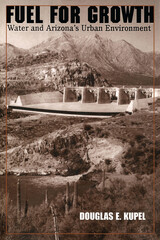 Fuel for Growth: Water and Arizona's Urban Environment
Douglas E. Kupel
University of Arizona Press, 2003 Cities in the arid West would not be what they are today without water and the technology needed to deliver it to users. The history of water development in Arizona goes hand in hand with the state's economic growth, and Arizona's future is inextricably tied to this scarce resource. Fuel for Growth describes and interprets the history of water resource development and its relationship to urban development in Arizona's three signature cities: Phoenix, Tucson, and Flagstaff. These three urban areas could hardly be more different: a growth-oriented metropolis, an environmentally conscious city with deep cultural roots, and an outdoor-friendly mountain town. Despite these differences, their community leaders and public officials have taken similar approaches to developing water resources with varying degrees of success and acceptance. Douglas Kupel has created a new vision of water history based on the Arizona experience. He challenges many of the traditional assumptions of environmental history by revealing that the West's aridity has had relatively little impact on the development of municipal water infrastructure in these cities. While urban growth in the West is often characterized as the product of an elite group of water leaders, the development of Arizona's cities is shown to reflect the broad aspirations of all their citizens. The book traces water development from the era of private water service to municipal ownership of water utilities and examines the impact of the post-World War II boom and subsequent expansion. Taking in the Salt River Project, the Central Arizona Project, and the Groundwater Management Act of 1980, Kupel explores the ongoing struggle between growth and environmentalism. He advocates public policy measures that can sustain a water future for the state. As the urban West enters a new century of water management, Arizona's progress will increasingly be tied to that of its ever-expanding cities. Fuel for Growth documents an earlier era of urban water use and provides important recommendations for the future path of water development in the West's key population centers.
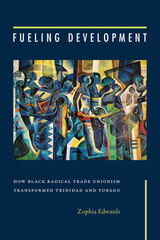 Fueling Development: How Black Radical Trade Unionism Transformed Trinidad and Tobago
Zophia Edwards
Duke University Press, 2025 Despite Trinidad and Tobago’s economic dependence on oil and gas production and its history of colonial exploitation of labor and resources, it enjoys relatively high democratic and redistributive development compared to other nations in the global South. In Fueling Development, Zophia Edwards draws on archival data, historical analysis, and Black radical political economic thought to trace Trinidad and Tobago’s success to a specific form of working-class mobilization she calls “liberation unionism.” A Black radical labor tradition, liberation unionism was multiracial, multisectoral, and gender inclusive; and Pan-African, anti-imperial, anticolonial, and diasporic; it advocated not only for workplace issues, but for economic, political, and social transformation. Emerging during the colonial period, liberation unionism forced the colonial state to increase its institutional capacity to promote equitable development. The movement persisted into the post-independence period and further compelled the independent state to channel oil windfalls toward increasing its ability to better serve the needs of the people. By uncovering liberation unionism’s power to create robust social and economic change, Edwards expands understandings of the relationship between development, race, labor, and political economy.
 Fueling Growth: The Energy Revolution and Economic Policy in Postwar Japan
Laura E. Hein
Harvard University Press, 1990 Fueling Growth examines post-World War II economic development in Japan through the prism of the energy sector. Energy, always a key problem for Japan, is an appropriate angle from which to view the changing economy and the development of economic policy during the Occupation years and after.
Between 1945 and 1960, Japan moved from a primary reliance on domestic coal and hydroelectricity to a dependence on imported oil. The debates over energy very quickly became debates over the viability and direction of the nation's entire economic strategy. Not surprisingly, given the high stakes involved, consensus on plans for economic growth was not attained automatically. Rancorous arguments, uncertainty, and ambivalence about development strategies were the precursors to the eventual forging of a workable policy. Hein describes in detail both the events in this process and the players: government officials, businessmen, labor unionists, and another, often under-emphasized contributor to Japanese postwar economic policy—the United States government, which set the parameters within which the Japanese could operate.
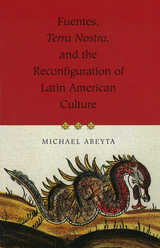 Fuentes, Terra Nostra, and the Reconfiguration of Latin American Culture
Michael Abeyta
University of Missouri Press, 2006
Widely acknowledged as Carlos Fuentes’s most ambitious novel, Terra Nostra is a paradigm-shifting work that has generated a virtual cottage industry of scholarly analysis. Michael Abeyta has now taken a new approach to this celebrated novel by considering how giving a gift is like telling a story.
Grounding his study on the work of Derrida and Bataille, Abeyta focuses on the theme of the gift in Terra Nostra, analyzing how gift giving, excess, expenditure, sacrifice, and exchange give shape to the novel. The question of giving leads him into contemplations of such parallel issues as money and exchange economies, the gift’s role in art and narration, and the Baroque in Latin American culture—an elaborate set of arguments that puts Fuentes’s understanding of Latin American culture in a surprising new light.
Blending literary theory with economic anthropology, philosophy, and Latin American studies, Abeyta analyzes the deconstructive functions of rhetorical figures and tropes in Terra Nostra to show how the novel’s revival of Baroque style integrates European and Nahuatl figural strategies. In the process, he reveals the novel’s relevance to current discussions about the relationship between art and the question of the gift. He then goes on to examine Fuentes’s Baroque in relation to Terra Nostra’s reconfiguration of Latin American cultural history.
Abeyta’s study opens new windows on this difficult work as he grapples intelligently with the sometimes dizzying conceptual dances that Fuentes performs. He shows how Fuentes’s rereading of Latin American history confronted important changes during the initial encounter between Europe and the Americas, which coincided with the spread of the European market and the shift from a gift to an exchange economy—from a culture in which economic relations were based on sacrifices, tributes, or gifts to one in which market forces predominated. He also engages in the recent scholarly debate on the potlatch and its implications in New World culture.
As Abeyta reveals, underlying Fuentes’s treatment of the gift is a deep questioning of utopian thought and its impact throughout Latin America’s history. His insights help define Terra Nostra’s place in current discussions in literary theory about art, economy, and the question of the gift, and this work stands to be hailed as one of the most perceptive readings of the novel yet to appear.
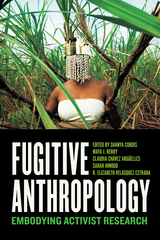 Fugitive Anthropology: Embodying Activist Research
Edited by Shanya Cordis, Maya J. Berry, Claudia Chávez Argüelles, Sarah Ihmoud, and R. Elizabeth Velásquez Estrada
University of Texas Press, 2026 A personal, provocative, and boundary-breaking volume on the power relations that racialized, gendered, and sexualized researchers grapple with while conducting activist research. Fugitive Anthropology is a transnational, intergenerational engagement that extends feminist theory, activist research methodologies, and the discipline of anthropology in new directions. Contributors examine the tensions that arise from conducting politically engaged, collaborative research alongside communities in struggle, in particular theorizing from the experiences of racialized women, queer, trans, and gender nonconforming researchers across distinct geographies. Essays contend with the matrices of colonial, imperial, and patriarchal violence that afflict the researchers and communities with which they seek political alignment. Articulating an ethnographic practice grounded in Black and Indigenous political struggles and committed to collective liberation, the volume reflects on what it means to navigate violent relations of power, systemic inequities, and current onslaughts shaping field research and US academia. Ultimately, Fugitive Anthropology argues that a feminist ethos—one that embraces embodied knowledges and fugitive sensibilities—forges liberatory spaces that break from dominant masculinist frames of the “political” and challenge colonial regimes within and beyond the neoliberal university.
 A Fugitive from Utopia: The Poetry of Zbignew Herbert
Stanislaw Baranczak
Harvard University Press, 1987 The leading Polish poet still residing in his native land, Zbigniew Herbert as not been the subject of a book-length study in English until now. Stanislaw Baranczak, himself a poet, critic, and translator, emigrated from Poland only in 1981, and is therefore eminently qualified to supply a politico-cultural context for Herbert while describing and analyzing the texts and themes of his poems.
Herbert's poetry is based on permanent confrontation--the confrontation of Western tradition with the experience of a "barbarian" from Eastern Europe, of the classical past with the modern era, of cultural myth with a practical, empirical point of view. Baranczak illustrates these oppositions by examining, first, the complex relations between "disinheritance" and "heritage" as they appear in Herbert's work on various structural levels, from symbolic key words to lyrical characters; second, the forms and functions of Herbert's "unmasking metaphor"; third, his uses of irony; fourth, his ethical system, which enables him to be both ironist and moralist. Baranczak pays special attention to irony as the most conspicuous feature of Herbert's poetic method.
A Fugitive from Utopia makes Herbert's poetic ideas fully accessible to the general reader, and will also be of interest to students of Polish literature, of East European culture and society, and of modern poetry. Those who have already encountered Herbert's poetry in one of the several translations into English currently available will welcome this lucid explication of his work.
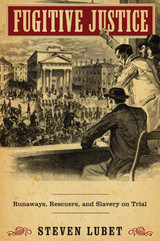 Fugitive Justice: Runaways, Rescuers, and Slavery on Trial
Steven Lubet
Harvard University Press, 2010 During the tumultuous decade before the Civil War, no issue was more divisive than the pursuit and return of fugitive slaves—a practice enforced under the Fugitive Slave Act of 1850. When free Blacks and their abolitionist allies intervened, prosecutions and trials inevitably followed. These cases involved high legal, political, and—most of all—human drama, with runaways desperate for freedom, their defenders seeking recourse to a “higher law” and normally fair-minded judges (even some opposed to slavery) considering the disposition of human beings as property.
Fugitive Justice tells the stories of three of the most dramatic fugitive slave trials of the 1850s, bringing to vivid life the determination of the fugitives, the radical tactics of their rescuers, the brutal doggedness of the slavehunters, and the tortuous response of the federal courts. These cases underscore the crucial role that runaway slaves played in building the tensions that led to the Civil War, and they show us how “civil disobedience” developed as a legal defense. As they unfold we can also see how such trials—whether of rescuers or of the slaves themselves—helped build the northern anti-slavery movement, even as they pushed southern firebrands closer to secession.
How could something so evil be treated so routinely by just men? The answer says much about how deeply the institution of slavery had penetrated American life even in free states. Fugitive Justice powerfully illuminates this painful episode in American history, and its role in the nation’s inexorable march to war.
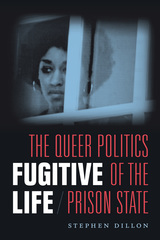 Fugitive Life: The Queer Politics of the Prison State
Stephen Dillon
Duke University Press, 2018 During the 1970s in the United States, hundreds of feminist, queer, and antiracist activists were imprisoned or became fugitives as they fought the changing contours of U.S. imperialism, global capitalism, and a repressive racial state. In Fugitive Life Stephen Dillon examines these activists' communiqués, films, memoirs, prison writing, and poetry to highlight the centrality of gender and sexuality to a mode of racialized power called the neoliberal-carceral state. Drawing on writings by Angela Davis, the George Jackson Brigade, Assata Shakur, the Weather Underground, and others, Dillon shows how these activists were among the first to theorize and make visible the links between conservative "law and order" rhetoric, free market ideology, incarceration, sexism, and the continued legacies of slavery. Dillon theorizes these prisoners and fugitives as queer figures who occupied a unique position from which to highlight how neoliberalism depended upon racialized mass incarceration. In so doing, he articulates a vision of fugitive freedom in which the work of these activists becomes foundational to undoing the reign of the neoliberal-carceral state.
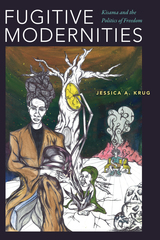 Fugitive Modernities: Kisama and the Politics of Freedom
Jessica A. Krug
Duke University Press, 2018 During the early seventeenth century, Kisama emerged in West Central Africa (present-day Angola) as communities and an identity for those fleeing expanding states and the violence of the trans-Atlantic slave trade. The fugitives mounted effective resistance to European colonialism despite—or because of—the absence of centralized authority or a common language. In Fugitive Modernities Jessica A. Krug offers a continent- and century-spanning narrative exploring Kisama's intellectual, political, and social histories. Those who became Kisama forged a transnational reputation for resistance, and by refusing to organize their society around warrior identities, they created viable social and political lives beyond the bounds of states and the ruthless market economy of slavery. Krug follows the idea of Kisama to the Americas, where fugitives in the New Kingdom of Grenada (present-day Colombia) and Brazil used it as a means of articulating politics in fugitive slave communities. By tracing the movement of African ideas, rather than African bodies, Krug models new methods for grappling with politics and the past, while showing how the history of Kisama and its legacy as a global symbol of resistance that has evaded state capture offers essential lessons for those working to build new and just societies.
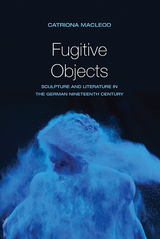 Fugitive Objects: Sculpture and Literature in the German Nineteenth Century
Catriona MacLeod
Northwestern University Press, 2014 Winner of the 2014 Jean-Pierre Barricelli Prize for Best Book on Romanticism
In Fugitive Objects, Catriona MacLeod examines the question of why sculpture is both intensively discussed and yet rendered immaterial in German literature. She focuses on three forms of disappearance: sculpture’s vanishing as a legitimate art form at the beginning of the nineteenth century in German aesthetics, statues’ migration from the domain of high art into mass reproduction and popular culture, and sculpture’s dislodging and relocation into literary discourse. Through original readings of Clemens Brentano, Achim von Arnim, Adalbert Stifter, Leopold von Sacher-Masoch, and others, MacLeod reveals that if sculpture has disappeared from much of nineteenth-century German literature and aesthetics, it is a vanishing act that paradoxically relocates the statue back onto another cultural pedestal, attesting to the powerful force of the medium.
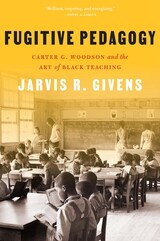 Fugitive Pedagogy: Carter G. Woodson and the Art of Black Teaching
Jarvis R. Givens
Harvard University Press, 2021 A fresh portrayal of one of the architects of the African American intellectual tradition, whose faith in the subversive power of education will inspire teachers and learners today.
“As departments…scramble to decolonize their curriculum, Givens illuminates a longstanding counter-canon in predominantly black schools and colleges.”
—Boston Review
“Informative and inspiring…An homage to the achievement of an often-forgotten racial pioneer.”
—Glenn C. Altschuler, Florida Courier
“A long-overdue labor of love and analysis…that would make Woodson, the ever-rigorous teacher, proud.”
—Randal Maurice Jelks, Los Angeles Review of Books
“Fascinating, and groundbreaking. Givens restores Carter G. Woodson, one of the most important educators and intellectuals of the twentieth century, to his rightful place alongside figures like W. E. B. Du Bois and Ida B. Wells.”
—Imani Perry, author of May We Forever Stand: A History of the Black National Anthem
Black education was subversive from its inception. African Americans pursued education through clandestine means, often in defiance of law and custom, even under threat of violence. They developed what Jarvis Givens calls a tradition of “fugitive pedagogy”—a theory and practice of Black education epitomized by Carter G. Woodson—groundbreaking historian, founder of Black History Month, and legendary educator under Jim Crow.
Givens shows that Woodson succeeded because of the world of Black teachers to which he belonged. Fugitive Pedagogy chronicles his ambitious efforts to fight what he called the “mis-education of the Negro” by helping teachers and students to see themselves and their mission as set apart from an anti-Black world. Teachers, students, families, and communities worked together, using Woodson’s materials and methods as they fought for power in schools. Forged in slavery and honed under Jim Crow, the vision of the Black experience Woodson articulated so passionately and effectively remains essential for teachers and students today.
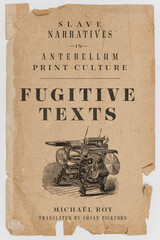 Fugitive Texts: Slave Narratives in Antebellum Print Culture
Michaël Roy, translated by Susan Pickford
University of Wisconsin Press, 2024 Antebellum slave narratives have taken pride of place in the American literary canon. Once ignored, disparaged, or simply forgotten, the autobiographical narratives of Frederick Douglass, Harriet Jacobs, and other formerly enslaved men and women are now widely read and studied. One key aspect of the genre, however, has been left unexamined: its materiality. What did original editions of slave narratives look like? How were these books circulated? Who read them?
In Fugitive Texts, Michaël Roy offers the first book-length study of the slave narrative as a material artifact. Drawing on a wide range of sources, he reconstructs the publication histories of a number of famous and lesser-known narratives, placing them against the changing backdrop of antebellum print culture. Slave narratives, he shows, were produced through a variety of print networks. Remarkably few were published under the full control of white-led antislavery societies; most were self-published and distributed by the authors, while some were issued by commercial publishers who hoped to capitalize on the success of Harriet Beecher Stowe’s Uncle Tom’s Cabin. The material lives of these texts, Roy argues, did not end within the pages. Antebellum slave narratives were “fugitive texts” apt to be embodied in various written, oral, and visual forms.
Published to rave reviews in French, Fugitive Texts illuminates the heterogeneous nature of a genre often described in monolithic terms and ultimately paves the way for a redefinition of the literary form we have come to recognize as “the slave narrative.”
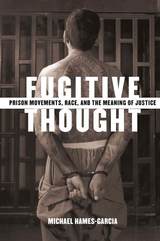 Fugitive Thought: Prison Movements, Race, And The Meaning Of Justice
Michael Hames-Garcia
University of Minnesota Press, 2004 Looks to the philosophy and experience of prisoners to reinvigorate our concepts of justice, solidarity, and freedom In Fugitive Thought, Michael Hames-García argues that writings by prisoners are instances of practical social theory that seek to transform the world. Unlike other authors who have studied prisons or legal theory, Hames-García views prisoners as political and social thinkers whose ideas are as valuable as those of lawyers and philosophers. As key moral terms like “justice,” “solidarity,” and “freedom” have come under suspicion in the post–Civil Rights era, political discussions on the Left have reached an impasse. Fugitive Thought reexamines and reinvigorates these concepts through a fresh approach to philosophies of justice and freedom, combining the study of legal theory and of prison literature to show how the critiques and moral visions of dissidents and participants in prison movements can contribute to the shaping and realization of workable ethical conceptions. Fugitive Thought focuses on writings by black and Latina/o lawyers and prisoners to flesh out the philosophical underpinnings of ethical claims within legal theory and prison activism.
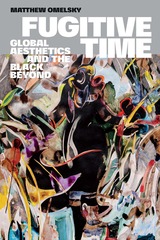 Fugitive Time: Global Aesthetics and the Black Beyond
Matthew Omelsky
Duke University Press, 2023 In Fugitive Time, Matthew Omelsky theorizes the embodied experience of time in twentieth- and twenty-first-century black artforms from across the world. Through the lens of time, he charts the sensations and coursing thoughts that accompany desires for freedom as they appear in the work of artists as varied as Toni Morrison, Yvonne Vera, Aimé Césaire, and Issa Samb. “Fugitive time” names a distinct utopian desire directed at the anticipated moment when the body and mind have been unburdened of the violence that has consumed black life globally for centuries, bringing with it a new form of being. Omelsky shows how fugitive time is not about attaining this transcendent release but is instead about sustaining the idea of it as an ecstatic social gathering. From the desire for ethereal queer worlds in the Black Audio Film Collective’s Twilight City to Sun Ra’s transformation of nineteenth-century scientific racism into an insurgent fugitive aesthetic, Omelsky shows how fugitive time evolves and how it remains a dominant form of imagining freedom in global black cultural expression.
The Fugitive’s Gibraltar: Escaping Slaves and Abolitionism in New Bedford, Massachusetts
Kathryn Grover
University of Massachusetts Press, 2001 We are currently updating our website and have not yet posted complete information for this title. Many of our books are in the Google preview program, which allows readers to view up to 20% of the book. If this title is active in the program, you will find the Google Preview button in the sidebar below.
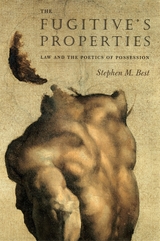 The Fugitive's Properties: Law and the Poetics of Possession
Stephen M. Best
University of Chicago Press, 2004 In this study of literature and law before and since the Civil War, Stephen M. Best shows how American conceptions of slavery, property, and the idea of the fugitive were profoundly interconnected. The Fugitive's Properties uncovers a poetics of intangible, personified property emerging out of antebellum laws, circulating through key nineteenth-century works of literature, and informing cultural forms such as blackface minstrelsy and early race films.
Best also argues that legal principles dealing with fugitives and indebted persons provided a sophisticated precursor to intellectual property law as it dealt with rights in appearance, expression, and other abstract aspects of personhood. In this conception of property as fleeting, indeed fugitive, American law preserved for much of the rest of the century slavery's most pressing legal imperative: the production of personhood as a market commodity. By revealing the paradoxes of this relationship between fugitive slave law and intellectual property law, Best helps us to understand how race achieved much of its force in the American cultural imagination. A work of ambitious scope and compelling cross-connections, The Fugitive's Properties sets new agendas for scholars of American literature and legal culture.
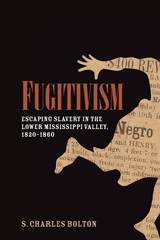 Fugitivism: Escaping Slavery in the Lower Mississippi Valley, 1820-1860
S. Charles Bolton
University of Arkansas Press, 2019 Winner, 2020 Booker Worthen Literary Prize
During the antebellum years, over 750,000 enslaved people were taken to the Lower Mississippi Valley, where two-thirds of them were sold in the slave markets of New Orleans, Natchez, and Memphis. Those who ended up in Louisiana found themselves in an environment of swamplands, sugar plantations, French-speaking creoles, and the exotic metropolis of New Orleans. Those sold to planters in the newly-opened Mississippi Delta cleared land and cultivated cotton for owners who had moved west to get rich as quickly as possible, driving this labor force to harsh extremes. Like enslaved people all over the South, those in the Lower Mississippi Valley left home at night for clandestine parties or religious meetings, sometimes “laying out” nearby for a few days or weeks. Some of them fled to New Orleans and other southern cities where they could find refuge in the subculture of slaves and free blacks living there, and a few attempted to live permanently free in the swamps and forests of the surrounding area. Fugitives also tried to returnto eastern slave states to rejoin families from whom they had been separated. Some sought freedom on the northern side of the Ohio River; othersfled to Mexico for the same purpose. Fugitivism provides a wealth of new information taken from advertisements, newspaper accounts, and court records. It explains how escapees made use of steamboat transportation, how urban runaways differed from their rural counterparts, how enslaved people were victimized by slave stealers, how conflicts between black fugitives and the white people who tried to capture them encouraged a culture of violence in the South, and how runaway slaves from the Lower Mississippi Valley influenced the abolitionist movement in the North. Readers will discover that along with an end to oppression, freedom-seeking slaves wanted the same opportunities afforded to most Americans.
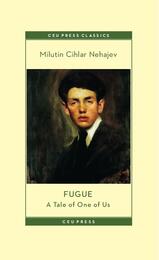 Fugue: A Tale of One of Us
Milutin Nehajev
Central European University Press, 2024 "Bijeg" is a novel by the Croatian writer Milutin Cihlar Nehajev, here translated into English by Damir Janigro with the title "Fugue." Regarded as a paramount example of Croatian literature from the Modernist era, it offers a captivating portrayal of the culture in pre-World War I Austro-Hungary. The story revolves around Duro, a talented and aspiring writer who abandons his studies in Vienna to take up a teaching position in Senj, a small coastal town in Croatia. Duro's aspirations include marrying a woman from Zagreb, but his plans are thwarted when her family objects due to the absence of the inheritance he had hoped for from his deceased uncle. The central theme of the novel explores the struggles faced by a gifted and principled individual in an inhospitable environment that often fails to comprehend his efforts to improve the world. The male and female characters are well-crafted and captivating, and the novel contains breathtaking descriptions of the natural beauty of the Croatian coast.
Fugues
Claribel Alegría, translated from the Spanish by D. J. Flakoll
Northwestern University Press, 1995 Well-known for her incisive descriptions of war and violence in El Salvador, Claribel Alegría is one of Central America's most eminent poets. In Fugues, a lucid and strikingly beautiful original collection, she looks squarely into the face of mortality, love, and aging, to explore the personal as well as universal questions that face each human being.
 Fujimori's Coup and the Breakdown of Democracy in Latin America
Charles D. Kenney
University of Notre Dame Press, 2004 “Charles Kenney has a sophisticated knowledge of his subject. He has the ability to bring his readers along and to immerse them in the fascinating developments of late twentieth-century politics in Peru.” —Henry Dietz, University of Texas, Austin
Much as Augusto Pinochet’s 1973 coup in Chile stood as a symbol of the challenges of an earlier period, Alberto Fujimori’s 1992 presidential coup became a symbol of the present challenges of democratization in Latin America and the world. In this authoritative book, Charles D. Kenney explores why and how democracy broke down in Peru in 1992. His analysis of Peruvian politics sheds light on the problems of democratic stability in new democracies and points to strategies for preventing future failures in other countries.
Kenney’s central argument is that institutional factors—especially the absence of a legislative majority—played a crucial role in the collapse of democracy in Peru in 1992 and throughout Latin America over the last forty years. This argument, which is theoretically and politically controversial in the case of Peru, is examined alongside alternative explanations of Fujimori’s coup. Kenney tests the Peruvian case study in a cross-national assessment of democratic breakdowns in Latin America since 1960. Containing a unique compilation of original quantitative data, Fujimori’s Coup and the Breakdown of Democracy in Latin America is the only book-length study to treat this subject. Kenney’s findings will be important for political scientists, scholars of Latin America, and policy makers.
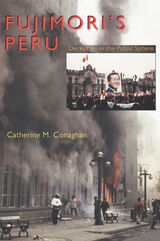 Fujimori's Peru: Deception in the Public Sphere
Catherine M Conaghan
University of Pittsburgh Press, 2006
Alberto Fujimori ascended to the presidency of Peru in 1990, boldly promising to remake the country. Ten years later, he hastily sent his resignation from exile in Japan, leaving behind a trail of lies, deceit, and corruption. While piecing together the shards of Fujimori’s presidency, prosecutors uncovered a vast criminal conspiracy fueled by political ambition and personal greed.
The Fujimori regime managed to maintain a facade of democracy while systematically eviscerating democratic institutions and the rule of law through legal subterfuge, intimidation, and outright bribery. The architect of this strategy was Fujimori’s notorious intelligence advisor, Vladimiro Montesinos. With great skill, Fujimori and Montesinos created the appearance of a democratic public sphere but ensured it would work only to suit their personal motives. The press was allowed to operate, but information exchange was under strict control. The more government officials tampered with the free flow of ideas, the more they inadvertently exposed the ills they were trying to cover up. And that proved to be their downfall.
Merging penetrating analysis and a journalist’s flair for narrative, Catherine Conaghan reveals the thin line between democracy and dictatorship, and shows how public institutions can both empower dictators and bring them down.
 Fujimori's Peru: The Political Economy
Edited by John Crabtree and Jim Thomas
University of London Press, 1998 This book provides an evaluation of Peruvian politics and economics in the 1990s, on the evidence available up until the end of 1997. The purpose is twofold: to detect continuities and discontinuities between the Fujimori period and earlier ones, and to offer an answer--however tentative--to the question of whether the Fujimori government has laid the basis for greater future stability. The answers to these questions are mixed. There appear to be more continuities than many suppose, even though 1990 in many ways was a 'turning point.' And while the Fujimori government helped provide a more stable context than the one it inherited, it is by no means clear that the changes it has brought about will prove sustainable over the longer run. The political model looks particularly brittle. The contributors are Luis Abugatt?s, Elena Alvarez, Javier de Bela.nde, John Crabtree, Carlos Iv?n Degregori, Francisco Durand, Adolfo Figueroa, Ra.l Hopkins, Javier Igu??iz, Drago Kisic, Enrique Obando, Martin Tanaka, Jim Thomas, and Rosemary Thorp. John Crabtree is a researcher at Oxford Analytica and a visiting research fellow at the Institute of Latin American Studies, University of London.
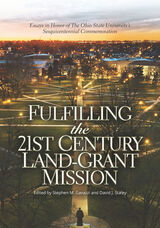 Fulfilling the 21st Century Land-Grant Mission: Essays in Honor of The Ohio State University’s Sesquicentennial Commemoration
Edited by Stephen M. Gavazzi and David J. Staley
Ohio State University Press, 2020 Over the past 150 years, land-grant universities—America’s first public institutions of higher learning—have had a profound impact on the well-being of our nation. Founded by the 1862 Morrill Land Grant Act and signed into law by President Abraham Lincoln, land-grant universities were given a three-part mission: to teach, to conduct research, and to engage communities across each state in order to meet their localized needs.
Gathered in honor of The Ohio State University’s sesquicentennial celebration, this collection of essays highlights the significant contributions that Ohio State continues to make as part of its twenty-first-century land-grant mission. Authors from across the university—representing fields as various as agriculture, dance, English, engineering, family science, geography, medicine, social work, and veterinary science—provide contributions that highlight the preeminent status of The Ohio State University. In addition, the perspectives of alumni, staff members, and senior administrators (both present and former) round out the picture of Ohio State as the first among equals regarding its land-grant peers. Overall, contributors draw on rich and varied institutional backgrounds to offer invaluable insights for higher education administrators and scholars across the US.
The Fulfillment of the Scriptures: Abraham, Moses, and Piers
Ruth W. Ames
Northwestern University Press, 1970 Ruth M. Ames’s The Fulfillment of Scriptures approaches Langland’s key medieval text, Piers Plowman, using critical literary methods developed in interdisciplinary programs that explore the intersections of religion and literature. Ames draws on the history of the development of Christian doctrine as she explores the ways that the allegory of Piers parallels the story of Jesus in Christian doctrine. Ames’s work offers a significantly new critical reading of Piers Plowman, influencing interpretations of medieval literature.
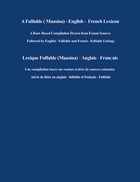 Fulfulde (Maasina) - English - French Lexicon: A Root-Based Compilation Drawn from Extant Sources
Donald W. Osborn
Michigan State University Press, 1993 The Lexicon brings together lexical material from a wide range of published and non-published sources to create an extensive compilation of the vocabulary of Fulfulde as it is spoken in that part of central Mali known as Masina (in Fulfulde, Maasina). The Lexicon is intended primarily for non-Fulfulde speakers who are learning the language at the intermediate or advanced levels and who need access to a comprehensive reference source on Fulfulde vocabulary. Scholars, development workers, and others whose research or fieldwork involves use of the Fulfulde of Masina may find it helpful as well in clarifying nuances of meaning and standardized spelling for the less familiar terms they might encounter. It is also intended that the present work, beyond the matter of organizing vocabulary, will contribute significantly to the expanding lexicographical and linguistic investigations of Fulfulde.
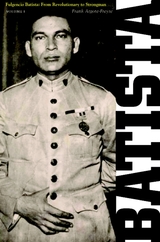 Fulgencio Batista: The Making of a Dictator
Argote-Freyre, Frank
Rutgers University Press, 2000 Pawn of the U.S. government. Right-hand man to the mob. Iron-fisted dictator. For decades, public understanding of the pre-Revolutionary Cuban dictator Fulgencio Batista has been limited to these stereotypes. While on some level they all contain an element of truth, these superficial characterizations barely scratch the surface of the complex and compelling career of this important political figure. Second only to Fidel Castro, Batista is the most controversial leader in modern Cuban history. And yet, until now, there has been no objective biography written about him. Existing biographical literature is predominantly polemical and either borders on hero worship or launches a series of attacks aimed at denigrating his entire legacy. In this book, the first of two volumes, Frank Argote-Freyre provides a full and balanced portrait of this historically shadowed figure. He describes Batista's rise to power as part of a revolutionary movement and the intrigues and dangers that surrounded him. Drawing on an extensive review of Cuban newspapers, government records, memos, oral history interviews, and a selection of Batista's personal documents, Argote-Freyre moves beyond simplistic caricatures to uncover the real man-one with strengths and weaknesses and with a career marked by accomplishments as well as failures. This volume focuses on Batista's role as a revolutionary leader from 1933 to 1934 and his image as a "strongman" in the years between 1934 and 1939. Argote-Freyre also uses Batista as an interpretive prism to review an entire era that is usually ignored by scholars-the Republican period of Cuban history. Bringing together global and local events, he considers the significance and relationship of the worldwide economic depression, the beginnings of World War II, and in Cuba, the Revolution of 1933, the expansion of the middle class, and the gradual development of democratic institutions. Fulgencio Batista and most of Cuba's past prior to the Revolution of 1959 has been lost in the historical mists. Cuba had a rich and fascinating history before the Marxist Revolution and the reign of Fidel Castro. This captivating and long-overdue book uncovers it.
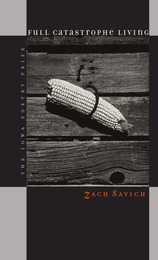 Full Catastrophe Living
Zach Savich
University of Iowa Press, 2009 Merging the spirits of Don Quixote, Shakespearean fools, Theodore Roethke, Frank O’Hara, James Merrill, and the Marx Brothers, Zach Savich’s first book does more than showcase the innovative fluency of its roving forms and moods: these poetic hybrids are not hothouse blossoms but minotaurs. With ebullient intelligence and high-stakes insistence on the panic, lust, and suffering of the sensual world, Full Catastrophe Living uses the self as an instrument to investigate art, love, and the hardest honesty.
In meditations, songs, slapstick sequences, sonnets, narratives, and tightly carved fragments, Savich explores the conflicts between romance and reality, between inventing a new world and staying true to this one. Relishing both traditional and experimental poetics, he takes refreshing, ecumenical risks to show the “strange grace / of bells that ring with a rag’s polishing.” Like a Fourth of July band conductor guiding planes to land, his poetic wit alters what’s real. This book will change the ways that readers think about poetry, language’s expressive capacity, and the robust world around us.
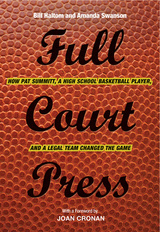 Full Court Press: How Pat Summitt, A High School Basketball Player, and a Legal Team Changed the Game
Bill Haltom
University of Tennessee Press, 2018 When Victoria Cape moved to Oak Ridge, Tennessee, in the early 1970s, she had no idea that her desire to play basketball would change the game for women and the sport in Tennessee. Encouraged to sign up for basketball by her athletic father, Victoria was in for a shock: the Tennessee Secondary School Athletic Association endorsed an entirely different form of the game for high school women than the version of basketball commonly played around the country. Women played six-on-six basketball, in which offensive players stayed on one half of the court, and defensive players on the other half—defenders could spend their entire careers without taking a shot. Victoria Cape sued the TSSAA, and her lawsuit paved the way for women to play basketball by the same rules as men and served as an early test case of groundbreaking Title IX legislation. Further adding to the case’s history-making précis was the presence of a young Pat Summitt, recently elevated to head coach of the Tennessee Lady Volunteers, who bravely testified on behalf of Cape during the lawsuit.
Full Court Press is a valuable addition to research on how individual initiative can bring about social change—in Tennessee, in the sporting world, and as a part of the broader struggle for women’s equality. Written in a lighthearted and inspiring style, this book is a must-read for anyone fascinated by the many achievements of Pat Summitt, Tennessee women’s basketball, or women’s sports history in general.
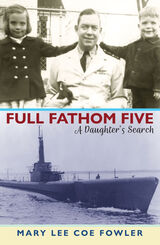 Full Fathom Five: A Daughter's Search
Mary Lee Coe Fowler
University of Alabama Press, 2008 One woman’s quest for knowledge of her father lost at sea
Mary Lee Coe Fowler was a posthumous child, born after her father, a submarine skipper in the Pacific, was lost at sea in 1943. Her mother quickly remarried into a difficult and troubled relationship, and Mary Lee’s biological father was never mentioned. It was not until her mother died and Mary Lee was a middle-aged adult that she set out to learn not only who her father was, but what happened to him and his crew, and why—and also to confront why she had shied away from asking these questions until it was nearly too late.
Fowler searched through old ships’ logs, letters, and naval communiqués; visited submarine museums, the Naval Academy, and other pertinent sites; interviewed old friends and crew members who knew her dad and mom or served concurrently; and slowly reconstructed the world in which they lived. Beautifully written, Fowler’s memoir reveals what she eventually learned: of the perils and harships of submarine service in wartime, of the tragic irony of how her father’s sub was probably lost, and of the long-term damage experienced by the families of those who do not come home from war.
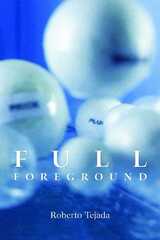 Full Foreground
Roberto Tejada
University of Arizona Press, 2012 Poet Roberto Tejada uses lyrical poems to explore and give a voice to the troubles of global citizenship, US–Mexico relations, Latino identity, and the political emotion of queer sexualities. His collection provides a holistic ground-level view of pivotal world events from the mid 1990s to a more recent present. Tejada’s innovative work dramatically widens the scope of Latina/o literature, showing us exactly what it can accomplish. The poems move very much like a three-act play, in which the first act is one of origins; the second, a staging of desire; and the third, a symbiosis. These acts magnify one another when unified. Each poem within the collection positions itself within the avant-garde, in which the artful use of language aims to dazzle, surprise, and enliven. The poems dance by, preserving a tension between hurry and delay, momentum and stasis, and every line is like a newly launched firecracker, sending out startling patterns of spark and flare. Tejada’s exuberant language stretches the limits of selfhood and the way it is represented in poetry. He illuminates the tangled webs that are woven when identities are linked to sexuality, nationality, privilege, and temporality. The concerns and obsessions voiced here turn the construction of desire on its head, forcing us to ask ourselves what is worthy of our attentions.
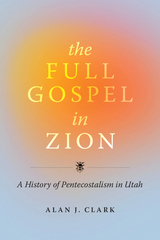 The Full Gospel in Zion: A History of Pentecostalism in Utah
Alan J. Clark
University of Utah Press, 2022 In The Full Gospel in Zion, Alan J. Clark explores the dynamic history of Pentecostalism in Utah. Although the story of Pentecostalism now spans the globe, there is no previous study of its growth and development among the mountains and valleys of the Beehive State. This book recovers and reveals the identities of the earliest Pentecostal pioneers across the state and places the founding churches within the historical narrative of Utah religion in the twentieth and early twenty-first centuries.
Utah Pentecostals faced difficulties establishing churches and congregations in a region dominated by a Latter-day Saint majority. Pentecostals found that they shared surprising similarities in belief but faced unexpected obstacles in evangelism, as Latter-day Saints did not respond as other Christians did to the Pentecostal message. Clark draws from interviews conducted with church leaders and congregants and from the rich documentary record to show Utah Pentecostals’ perseverance in creating a strong foothold in Utah. His work offers a new look at the diversity and richness of Utah’s religious history.
Full House: The Spread of Excellence from Plato to Darwin
Stephen Jay Gould
Harvard University Press, 2011 Gould shows why a more accurate way of understanding our world is to look at a given subject within its own context, to see it as a part of a spectrum of variation and then to reconceptualize trends as expansion or contraction of this “full house” of variation, and not as the progress or degeneration of an average value, or single thing.
A Full Life in a Small Place and Other Essays from a Desert Garden
Janice Emily Bowers
University of Arizona Press, 1993 The frustrations and pleasures of gardening are evident; its implications for life are more subtle, lurking under a leaf or buried in a compost pile. Janice Emily Bowers senses these implications, and communicates them as only a fine writer can. In A Full Life in a Small Place, she shows how backyard gardening opens up a broader appreciation of both life and living. Her observations on organic gardening inspire further meditations on nature and wildlife, and demonstrate how gardens both complicate and enrich our lives. In their entirety, these sixteen essays ask how we shall live, and recognize that "before we can determine how, we need to find out why."
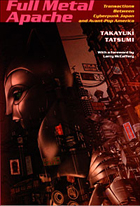 Full Metal Apache: Transactions Between Cyberpunk Japan and Avant-Pop America
Takayuki Tatsumi
Duke University Press, 2006 Takayuki Tatsumi is one of Japan’s leading cultural critics, renowned for his work on American literature and culture. With his encyclopedic knowledge and fan’s love of both Japanese and American art and literature, he is perhaps uniquely well situated to offer this study of the dynamic crosscurrents between the avant-gardes and pop cultures of Japan and the United States. In Full Metal Apache, Tatsumi looks at the work of artists from both sides of the Pacific: fiction writers and poets, folklorists and filmmakers, anime artists, playwrights, musicians, manga creators, and performance artists. Tatsumi shows how, over the past twenty years or so, writers and artists have openly and exuberantly appropriated materials drawn from East and West, from sources both high and low, challenging and unraveling the stereotypical images Japan and America have of one another. Full Metal Apache introduces English-language readers to a vast array of Japanese writers and performers and considers their work in relation to the output of William Gibson, Thomas Pynchon, H. G. Wells, Jack London, J. G. Ballard, and other Westerners. Tatsumi moves from the poetics of metafiction to the complex career of Madame Butterfly stories and from the role of the Anglo-American Lafcadio Hearn in promoting Japanese folklore within Japan during the nineteenth century to the Japanese monster Godzilla as an embodiment of both Japanese and Western ideas about the Other. Along the way, Tatsumi develops original arguments about the self-fashioning of “Japanoids” in the globalist age, the philosophy of “creative masochism” inherent within postwar Japanese culture, and the psychology of “Mikadophilia” indispensable for the construction of a cyborg identity. Tatsumi’s exploration of the interplay between Japanese and American cultural productions is as electric, ebullient, and provocative as the texts and performances he analyzes.
Full Metal Jhacket
Matthew Derby
University of Michigan Press, 2014 Two boys discover that the title of their stop-motion animated film about Vietnam has been taken by director Stanley Kubrick. A 150-year-old woman on the run from the government is tracked down by the company who extended her life. A military contractor carrying his robot son in a gym bag struggles to find his way out of the Nigerian delta during a bloody civil war. The wife of an up-and-coming politician grieves his infidelity by prowling rooftops with a sniper rifle. Following his celebrated debut collection, Super Flat Times, Matthew Derby delivers a disturbing new set of stories that plunges us into a lonely heartland of misfits, outcasts, and would-be assassins who lurk in the shadows, searching for connection and meaning in all the wrong places.
Full Moon at Noontide: A Daughter's Last Goodbye
Ann Putnam
University of Iowa Press, 2015 Full Moon at Noontide is the story of Ann Putnam’s mother and father and her father’s identical twin, and how they lived together with their courage and their stumblings, as they made their way into old age and then into death. It’s the story of the journey from one twin’s death to the other, of what happened along the way, of what it means to lose the other who is also oneself. And it’s the story of how Ann Putnam herself struggled to save them and could not, and how she dealt with the weight of guilt, of worrying that she had not done enough, said enough, stayed long enough for them all. How she learned that through this long journey all that was really needed was love.
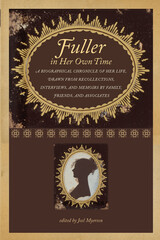 Fuller in Her Own Time: A Biographical Chronicle of Her Life, Drawn from Recollections, Interviews, and Memoirs by Family, Friends, and Associates
Joel Myerson
University of Iowa Press, 2008 Writer, editor, journalist, educator, feminist, conversationalist, and reformer Margaret Fuller (1810–1850) was one of the leading intellectuals of nineteenth-century America as well as a prominent member of Concord literary circles. Yet the challenging spirit behind her intellectual confidence and mesmerizing energy led to the invention of an unbalanced legacy that denied her a place among the canonical Concord writers. This collection of first-hand reminiscences by those who knew Fuller personally rescues her from these confusions and provides a clearer identity for this misrepresented personality.
The forty-one remembrances from Nathaniel Hawthorne, Oliver Wendell Holmes, Ralph Waldo Emerson, Thomas Carlyle, Harriet Martineau, Henry James, and twenty-four others chart Fuller’s expanding influence from schooldays in Boston, meetings at the Transcendental Club, teaching in Providence and Boston, work on the New York Tribune, publications and conversations, travels in the British Isles, and life and love in Italy before her tragic early death. Joel Myerson’s perceptive introduction assesses the pre- and postmortem building of Fuller’s reputation as well as her relationship to the prominent Transcendentalists, reformers, literati, and other personalities of her time, and his headnotes to each selection present valuable connecting contexts.
The woman who admitted that “at nineteen she was the most intolerable girl that ever took a seat in a drawing-room,” whose Woman in the Nineteenth Century is considered the first major book-length feminist call to action in America, never conformed to nineteenth-century expectations of self-effacing womanhood. The fascinating contradictions revealed by these narratives create a lively, lifelike biography of Fuller’s “rare gifts and solid acquirements . . . and unfailing intellectual sympathy.”
 The Fullness of Being: A New Paradigm for Existence
Barry Miller
University of Notre Dame Press, 2002 According to a fairly standard view, there are several reasons for denying that existence is a real property of individuals. One is that 'exists' cannot be predicated of individuals, and another is that first-level properties are parasitic on individuals for their actuality, which is something that existence could never be. A third is that existence adds nothing to individuals. Moreover, even if existence were to survive all three counter-indications, it would be merely the most vacuous of properties. The Fullness of Being, however, argues that this view of existence is seriously awry. In this brilliant book, Barry Miller argues that existence is not merely a real property of individuals, but by far the richest of their properties.
The commonly accepted view of existence is testimony, contends Miller, to what happens when wrong questions are asked, false assumptions are made, and the possibility of a new paradigm for existence is dismissed without consideration. They bear witness to the substantial flaws underlying the familiar claim 'existence is not a predicate' and the Frege-Russell-Quine view not only of 'exists' as exclusively a second-level predicate, but of existence as no more than a Cambridge property of individuals.
By way of contrast, The Fullness of Being is an account of what happens when different questions are asked, when false assumptions are eschewed, and when the possibility of a radically different paradigm for existence is actively
explored rather than completely ignored. What began for Miller as an exercise in philosophical logic to determine whether 'exists' is predicable of individuals, ends in an argument with groundbreaking consequences for ontology.
BARRY MILLER is honorary fellow at the University of New England, Armidale, Australia. He is the author of numerous books and articles, including A Most Unlikely God, also published by the University of Notre Dame Press.
Reviews
"The Fullness of Being is a brilliant and original account of existence. It will be required reading for those philosophers interested in the topic." --Peter Forrest, professor of philosophy, University of New England, Australia
"This book does a valuable service by clearing up some long-standing confusions on the question whether exists is a meaningful predicate. M. ingeniously shows how the predicate exists does not signify merely a minimum level of being; it also signifies that by which all the other real properties of anything are constituted as real..."--Theological Studies, June 2003, Vol. 64, No. 2
"Miller's work on existence is a remarkable achievement.... It should be required reading for those philosophers interested in the topic of existence, and it is a significant contgribution to philosophical theology."--Notre Dame Philosophical Reviews, August, 1, 2002
The Fullness of Divine Worship: The Sacred Liturgy and its Renewal
Uwe Michael Lang
Catholic University of America Press, 2018 This volume offers a selection of essays from the pages of Antiphon: A Journal for Liturgical Renewal, the official organ of the Society for Catholic Liturgy. The Society was founded in 1995 as a multidisciplinary association of Catholic scholars, teachers, pastors, and ecclesiastical professionals in the Anglophone world, with the aim of promoting the scholarly study and practical renewal of the sacred liturgy.
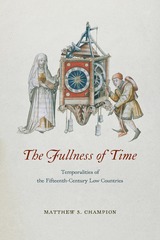 The Fullness of Time: Temporalities of the Fifteenth-Century Low Countries
Matthew S. Champion
University of Chicago Press, 2017 The Low Countries were at the heart of innovation in Europe in the fifteenth century. Throughout this period, the flourishing cultures of the Low Countries were also wrestling with time itself. The Fullness of Time explores that struggle, and the changing conceptions of temporality that it represented and embodied showing how they continue to influence historical narratives about the emergence of modernity today.
The Fullness of Time asks how the passage of time in the Low Countries was ordered by the rhythms of human action, from the musical life of a cathedral to the measurement of time by clocks and calendars, the work habits of a guildsman to the devotional practices of the laity and religious orders. Through a series of transdisciplinary case studies, it explores the multiple ways that objects, texts and music might themselves be said to engage with, imply, and unsettle time, shaping and forming the lives of the inhabitants of the fifteenth-century Low Countries. Champion reframes the ways historians have traditionally told the history of time, allowing us for the first time to understand the rich and varied interplay of temporalities in the period.
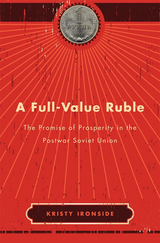 A Full-Value Ruble: The Promise of Prosperity in the Postwar Soviet Union
Kristy Ironside
Harvard University Press, 2021 A new history shows that, despite Marxism’s rejection of money, the ruble was critical to the Soviet Union’s promise of shared prosperity for its citizens.
In spite of Karl Marx’s proclamation that money would become obsolete under Communism, the ruble remained a key feature of Soviet life. In fact, although Western economists typically concluded that money ultimately played a limited role in the Soviet Union, Kristy Ironside argues that money was both more important and more powerful than most histories have recognized. After the Second World War, money was resurrected as an essential tool of Soviet governance. Certainly, its importance was not lost on Soviet leaders, despite official Communist Party dogma. Money, Ironside demonstrates, mediated the relationship between the Soviet state and its citizens and was at the center of both the government’s and the people’s visions for the maturing Communist project. A strong ruble—one that held real value in workers’ hands and served as an effective labor incentive—was seen as essential to the economic growth that would rebuild society and realize Communism’s promised future of abundance.
Ironside shows how Soviet citizens turned to the state to remedy the damage that the ravages of the Second World War had inflicted upon their household economies. From the late 1940s through the early 1960s, progress toward Communism was increasingly measured by the health of its citizens’ personal finances, such as greater purchasing power, higher wages, better pensions, and growing savings. However, the increasing importance of money in Soviet life did not necessarily correlate to improved living standards for Soviet citizens. The Soviet government’s achievements in “raising the people’s material welfare” continued to lag behind the West’s advances during a period of unprecedented affluence. These factors combined to undermine popular support for Soviet power and confidence in the Communist project.
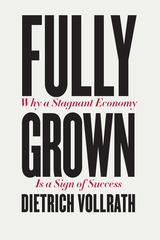 Fully Grown: Why a Stagnant Economy Is a Sign of Success
Dietrich Vollrath
University of Chicago Press, 2019 Vollrath challenges our long-held assumption that growth is the best indicator of an economy’s health.
Most economists would agree that a thriving economy is synonymous with GDP growth. The more we produce and consume, the higher our living standard and the more resources available to the public. This means that our current era, in which growth has slowed substantially from its postwar highs, has raised alarm bells. But should it? Is growth actually the best way to measure economic success—and does our slowdown indicate economic problems?
The counterintuitive answer Dietrich Vollrath offers is: No. Looking at the same facts as other economists, he offers a radically different interpretation. Rather than a sign of economic failure, he argues, our current slowdown is, in fact, a sign of our widespread economic success. Our powerful economy has already supplied so much of the necessary stuff of modern life, brought us so much comfort, security, and luxury, that we have turned to new forms of production and consumption that increase our well-being but do not contribute to growth in GDP.
In Fully Grown, Vollrath offers a powerful case to support that argument. He explores a number of important trends in the US economy: including a decrease in the number of workers relative to the population, a shift from a goods-driven economy to a services-driven one, and a decline in geographic mobility. In each case, he shows how their economic effects could be read as a sign of success, even though they each act as a brake of GDP growth. He also reveals what growth measurement can and cannot tell us—which factors are rightly correlated with economic success, which tell us nothing about significant changes in the economy, and which fall into a conspicuously gray area.
Sure to be controversial, Fully Grown will reset the terms of economic debate and help us think anew about what a successful economy looks like.
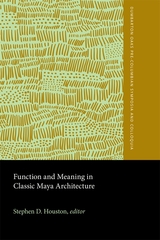 Function and Meaning in Classic Maya Architecture: A Symposium at Dumbarton Oaks, 7th and 8th October 1994
Stephen D. Houston
Harvard University Press, 1998 Investigations of Maya architecture have been among the chief vehicles for contemplating a great art tradition, the hieroglyphic writing system, and evaluating issues of comparative sociology. The powerful attraction of Maya architecture as an evocation of lost worlds, as a medium for the carved glyph and idol, and as a yardstick for measuring evolutionary complexity, makes it appropriate that attention be given to the buildings themselves, rather than simply treating them as media for the investigation of other issues, as valuable as these might be. The articles in this volume are of special value and importance in making architecture itself the focus of attention. At the same time that they give appropriate attention to the great architectural achievements of the Maya, they do not ignore the often evanescent residences of commoners. Rather than privileging cross-cultural comparisons or the anthropology of prehistoric peoples, however, structures remain at the forefront. In this, we reaffirm Maya architecture as one of the world’s great building traditions, allow for meaningful interdisciplinary exchange between archaeology, art history, and anthropology, and provide new ways of appreciating Maya culture, from a unique perspective.
The contributions presented here will surely mark a significant stage in the study of Maya architecture and the society that built it. These articles represent the advances that have been achieved in our understandings of the past, point toward avenues for further studies, and note the distance we have yet to travel in fully appreciating and understanding this ancient American culture and its material remains.
Function Of Criticism: Problems and Exercises
Yvor Winters
Ohio University Press, 1957 The Function of Criticism: Problems and Exercises brings together five essays by Yvor Winters: “Problems for the Modern Critic of Literature,” “The Audible Reading of Poetry,” “The Poetry of Gerard Manley Hopkins,” “Robert Frost, Or the Spiritual Drifter as Poet,” and “English Literature in the Sixteenth Century.”
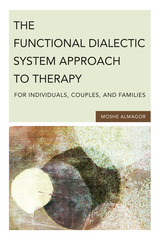 The Functional Dialectic System Approach to Therapy for Individuals, Couples, and Families
Moshe Almagor
University of Minnesota Press, 2011 The functional dialectic system approach to therapy has been widely embraced and is now used internationally, with individuals and couples as well as with families. It differs substantially from the common psychotherapeutic models that have prevailed in the West for more than a century. According to the system model, an individual who is in treatment is not considered to be the primary focus of interest but is seen instead as part of a social context, the network of relationships that play significant roles in his or her life. In this book, Moshe Almagor offers a comprehensive view of the contemporary system approach—from theory to practice—and shows how it can be applied to a variety of psychological problems and in a variety of therapeutic modes. The system approach to therapy concentrates on the present situation of a client, aware that people are always in transition yet seeking order, safety, belonging, and identity. Their behavior is thus goal oriented and functional. The principles of dialectics assert that everything includes its opposite, that there is an ongoing conflict between the poles, and that this inevitable conflict creates pressure that leads to a continuous alteration. These principles, thoroughly explained in the book and practically illustrated by case examples drawn from the author’s own practice, show how the system approach is optimistic in its orientation and is designed to help clients change their lives by broadening their understanding of themselves, their situations, and their options.
Functionalism Historicized: Essays on British Social Anthopology
Edited by George W. Stocking, Jr.
University of Wisconsin Press, 1988 " This volume is likely to prove indispensable to historians of anthropology in general and of British anthropology in particular. There are a wide range of historical skills on display, from traditional textual analysis to historical sociology of the most sophisticated sort, and there is a more or less thorough chronological coverage from the era of classical evolutionism virtually up to the present. One can only hope that historicizing anthropologists will sample some of these wares."—Journal of the History of the Behavioral Sciences
Functionality-Enhanced Devices: An alternative to Moore's Law
Pierre-Emmanuel Gaillardon
The Institution of Engineering and Technology, 2019 This book discusses one possible solution to the key issue in electronics engineering - the approaching limits of CMOS scaling - by taking advantage of the tendency of Schottky contacts to form at channel interfaces in nanoscale devices. Rather than suppressing this phenomenon, a functionality-enhanced device exploits it to increase switching functionality. These devices are Multiple-Independent-Gate-Field-Effect-Transistors, and other related nanoscale devices, whose polarity is electrostatically controllable. The functionality enhancement of these devices increases computational performance (function) per unit area and leads to circuits with better density, performance and energy efficiency.
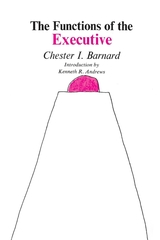 The Functions of the Executive: Thirtieth Anniversary Edition
Chester I. Barnard
Harvard University Press, 1968 Most of Chester Barnard’s career was spent in executive practice. A Mount Hermon and Harvard education, cut off short of the bachelor’s degree, was followed by nearly forty years in the American Telephone & Telegraph Company. His career began in the Statistical Department, took him to technical expertness in the economics of rates and administrative experience in the management of commercial operations, and culminated in the presidency of the New Jersey Bell Telephone Company. He was not directly involved in the Western Electric experiments conducted chiefly at the Hawthorne plant in Cicero, but his association with Elton Mayo and the latter’s colleagues at the Harvard Business School had an important bearing on his most original ideas.
Barnard’s executive experience at AT&T was paralleled and followed by a career in public service unusual in his own time and hardly routine today. He was at various times president of the United Services Organization (the USO of World War II), head of the General Education Board and later president of the Rockefeller Foundation (after Raymond Fosdick and before Dean Rusk), chairman of the National Science Foundation, an assistant to the Secretary of the Treasury, a consultant to the American representative in the United Nations Atomic Energy Committee, to name only some of his public interests. He was a director of a number of companies, a fellow of the American Association for the Advancement of Science and of the American Academy of Arts and Sciences. He was a lover of music and a founder of the Bach Society of New Jersey.
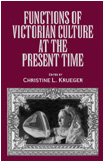 Functions of Victorian Culture at the Present Time
Christine L. Krueger
Ohio University Press, 2002 We are over a a century removed from Queen Victoria's death, yet the culture that bears her name is alive and well across the globe. Not only is Victorian culture the subject of lively critical debate; it draws widespread interest from popular audiences and consumers. Functions of Victorian Culture at the Present Time addresses the theme of the Victorians' continuing legacy and its effect on our own culture and perception of the world. The contributors' diverse topics include the persistent influence of Jack the Ripper on police procedures, the enormous success of the magazine Victoria and the lifestyle it promotes, and film, television, and theatrical adaptations of Victorian texts. Also addressed are appropriations of Oscar Wilde to market gay identity in contemporary advertising, and appeals to the Victorian empire in constructing the New Britain for the era of globalization. Functions of Victorian Culture at the Present Time encourages a critique of how these artifacts contribute to contemporary culture and confronts the challenges of disseminating the older culture in the new millennium. The contributors include Simon Joyce, Ronald R. Thomas, Miriam Bailin, Ellen Bayuk Rosenman, Jesse Matz, Sharon Aronofsky Weltman, Kathleen Lonsdale, Christine L. Krueger, Florence Boos, David Barndollar, Susan Schorn, and Sue Lonoff.
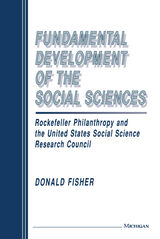 Fundamental Development of the Social Sciences: Rockefeller Philanthropy and the United States Social Science Research Council
Donald Fisher
University of Michigan Press, 1993 The United States Social Science Research Council (SSRC), founded in 1923, was the first national social science institution in the world and might be said to represent the creation of a "science of society." In Fundamental Development of the Social Sciences , Donald Fisher shows how this institution, under the considerable influence of Rockefeller philanthropy, shaped an entire discipline. Fisher demonstrates that the creation and growth of the SSRC during the 1920s and 1930s is essential to our understanding of the major developments in the social sciences since World War II. He shows that during this period, the place of social science and social scientists in American society was fixed in a way that has had substantial, lasting impact. The author weaves a number of larger, related issues into his account of the wide-ranging influence of the SSRC: the role of social scientists in the political life of the societies in which they live; the way in which knowledge systems develop and change; the role of philanthropy in industrialized societies; and the formation and preservation of the modern capitalist state. Donald Fisher's discussion of how an American institution sculpted an entire discipline will be of interest to all social scientists and historians of social science.
 Fundamental Ethics: A Liberationist Approach
Patricia McAuliffe
Georgetown University Press, 1993 In this stimulating rethinking of the basic foundations of ethics, Patricia McAuliffe derives a fundamental ethic from liberation theology. She asserts that the experience of resisting suffering, especially oppressive social suffering, must be brought from the fringe to the very center of ethics. Arguing for the conceptual priority of ethics over religion, McAuliffe defines an innovative ethic based on experience and practice. Ethics precedes religion and theology because experience and practice precede theory and interpretation, which are the human activities of religion and theology—knowledge is based on experience. She proposes that ethics can be independent of religion, but that while her liberationist ethic can be either Christian or universal, finally the poor and oppressed are the paradigm source of the disclosure of God and of final salvation. In rethinking the basic foundations of ethics, she compares a liberationist ethic, including Latin American and women's liberation theology, with various classical ethics, and examines and critiques the works of Edward Schillebeeckx, Juan Luis Segundo, Dorothee Soelle, James Gustafson, and George Lindbeck. McAuliffe offers a flexible ethic that balances the absolute and the relative, the particular and the universal, personal and social, creativity and conditioning, practice and theory, and the ethical and religious. Combining superior scholarship with an original and creative approach to ethics, this book is likely to create debate in the fields of fundamental ethics, theology, and philosophy.
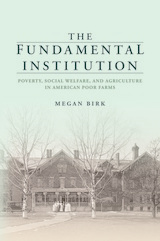 The Fundamental Institution: Poverty, Social Welfare, and Agriculture in American Poor Farms
Megan Birk
University of Illinois Press, 2022 By the early 1900s, the poor farm had become a ubiquitous part of America's social welfare system. Megan Birk's history of this foundational but forgotten institution focuses on the connection between agriculture, provisions for the disadvantaged, and the daily realities of life at poor farms. Conceived as an inexpensive way to provide care for the indigent, poor farms in fact attracted wards that ranged from abused wives and the elderly to orphans, the disabled, and disaster victims. Most people arrived unable rather than unwilling to work, some because of physical problems, others due to a lack of skills or because a changing labor market had left them behind. Birk blends the personal stories of participants with institutional histories to reveal a loose-knit system that provided a measure of care to everyone without an overarching philosophy of reform or rehabilitation. In-depth and innovative, The Fundamental Institution offers an overdue portrait of rural social welfare in the United States.
Fundamental Issues in the Romance Languages
Edited by Danièle Godard
CSLI, 2010 Fundamental Issues in the Romance Languages compares six Romance languages—Catalan, French, Spanish, Italian, Portuguese, and Romanian—and summarizes the last thirty years of scholarship in the fields of morphology, syntax, semantics, and discourse for each language. The up-to-date analyses in this volume make it essential for undergraduate and graduate students as well as scholars of each language.
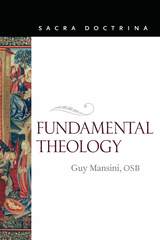 Fundamental Theology
Guy Mansini, OSB
Catholic University of America Press, 2018 Fundamental Theology examines the light by which the mysteries of Christ and the Church, the Trinity and the Sacraments, are revealed to us. That light we call "revelation," and fundamental theology examines in the first place what this light shows about itself, and how it is sustained in the world. Or again, fundamental theology considers what the word of God has to say both about itself and what it has to say about where in the world it is to be heard. So, first it is a theology of Revelation (chapter 1), and second, a theology of the transmission of Revelation in Tradition, Scripture, and the Church (chapters 2, 3, and 4). Why must Revelation have the shape it does, and why must it be constituted by both word and event? Why is Tradition prior to Scripture, why must the word of God be written down, and why must Scripture come to us in two testaments? And why must the message conveyed in Tradition and Scripture have a living interpreter in the Church?
Since no word is spoken unless it is heard, fundamental theology also investigates the conditions of hearing the word of God, the very hearing itself in the assent of faith, and a necessary consequence of this hearing. The remote conditions of hearing are also what theology calls our ability to come to the knowledge of the preambula fidei- the things about God than can be known by the natural light (chapter 5). The immediate condition of hearing is the credibility of the word (chapter 6). Hearing is faith (chapter 7). And true hearing gives the hearer to recapitulate what is heard in his own wondering and thankful voice in theology (chapter 8). The introduction to theology in the last chapter is by way of considering the history of Catholic theology in the 20th century.
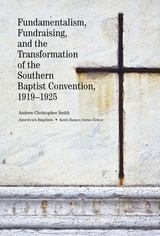 Fundamentalism, Fundraising, and the Transformation of the Southern Baptist Convention, 1919–1925
Andrew Christopher Smith
University of Tennessee Press, 2016 Scholars and journalists have paid significant attention to the contemporary Fundamentalist tendencies of southern Protestantism. However, many studies neglect to consider how the Fundamentalist controversies that roiled the Baptists and Presbyterians of the North during the 1920s affected the Southern Baptist Convention schism of 1970–2000.
Fundamentalism, Fundraising, and the Transformation of the Southern Baptist Convention, 1919–1925 explores the scope and character of the interaction between Southern Baptists and early Fundamentalism during the late 1910s and early 1920s. By focusing more closely on the Southern Baptist Convention, Andrew Christopher Smith examines the interaction between the northern Fundamentalist movement and southern religion during the era. Though scholars agree that Fundamentalism is not native to the South, no book thus far has considered the effects of the Fundamentalist movement and how it influenced southern Protestant denominational organizations, independent of southern rejection of Fundamentalist-sponsored interdenominational evangelistic and educational institutions. Smith proposes that Fundamentalist ideas, lingering in the atmosphere of the South after wafting there through hearsay, national religious periodicals, and the secular press,likely influenced Southern Baptist self-understanding during this critical period.
Examining documentary evidence, Smith explains that following the First World War, Southern Baptists pushed toward bureaucratization. The “Seventy-Five Million Campaign,” a fundraising and organization-building drive that the convention approved in 1919, was the denominational movement through which the selective appropriation of Fundamentalist ideas occurred. Exploring the interplay of Southern Baptist claims and northern Fundamentalist precepts, Smith fills a void in scholarly examination of early-twentieth-century Baptist history.
ANDREW C. SMITH is assistant professor of religion at Carson-Newman University. His articles have appeared in Perspectives in Religious Studies, Baptist History and Heritage, and Tennessee Baptist History.
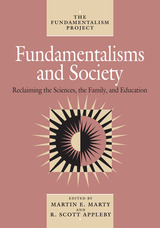 Fundamentalisms and Society: Reclaiming the Sciences, the Family, and Education
Edited by Martin E. Marty and R. Scott Appleby
University of Chicago Press, 1993 The Fundamentalism Project
Edited by Martin E. Marty and R. Scott Appleby
Around the world, fundamentalist movements are profoundly
affecting the way we live. Misinformation and misperception
about fundamentalism exacerbate conflicts at home and abroad.
Yet policymakers, journalists, students, and others have
lacked any comprehensive resource on the explosive phenomenon
of fundamentalism. Now the Fundamentalism Project has
assembled an international team of scholars for a multivolume
assessment of the history, scope, sources, character, and
impact of fundamentalist movements within the world's major
religious traditions.
Fundamentalisms and Society shows how fundamentalist
movements have influenced human relations, education, women's
rights, and scientific research in over a dozen nations and
within the traditions of Islam, Judaism, Christianity,
Buddhism, and Hinduism. Drawn from the fields of
anthropology, sociology, history of religion, and history of
science, the contributors cover topics such as the
educational structures of Hindu revivalism, women in
fundamentalist Iran and Pakistan, and the creationist cosmos
of Protestant fundamentalism. In a concluding essay, William
H. McNeill situates contemporary fundamentalisms within a
world historical context.
The Fundamentalism Project, Volume 2
Martin E. Marty and R. Scott Appleby direct the
Fundamentalism Project. Marty, the Fairfax M. Cone
Distinguished Service Professor of the History of Modern
Christianity at the University of Chicago, is the senior
editor of the Christian Century and the author of
numerous books, including the multivolume Modern American
Religion, also published by the University of
Chicago Press. Appleby, a research associate at the
University of Chicago, is the author of “Church and
Age Unite!” The Modernist Impulse in American
Catholicism.
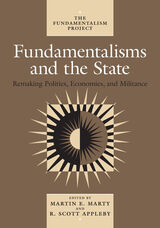 Fundamentalisms and the State: Remaking Polities, Economies, and Militance
Edited by Martin E. Marty and R. Scott Appleby
University of Chicago Press, 1996 Do fundamentalisms tend toward political activism, and how
successful have they been in remaking political structures?
To answer this question, the contributors to this volume—
political scientists, historians of religion,
anthropologists, and sociologists—discuss the anti-
abortion movement, Operation Rescue in the United States, the
Islamic war of resistance in Afghanistan, Shi'ite
jurisprudence in Iran, and other issues. The volume
considers the effect that antisecular religious movements
have had over the past twenty-five years on national
economies, political parties, constitutional issues, and
international relations on five continents and within the
traditions of Islam, Christianity, Judaism, Buddhism,
Hinduism, and Sikhism. Marty and Appleby conclude with a
synthetic statement on the fundamentalist impact on polities,
economies, and state security.
The Fundamentalism Project, Volume 3
Martin E. Marty and R. Scott Appleby direct the
Fundamentalism Project. Marty, the Fairfax M. Cone
Distinguished Service Professor of the History of Modern
Christianity at the University of Chicago, is the senior
editor of the Christian Century and the author of
numerous books, including the multivolume Modern American
Religion, also published by the University of
Chicago Press. Appleby, a research associate at the
University of Chicago, is the author of “Church and
Age Unite!” The Modernist Impulse in American
Catholicism.
Fundamentalisms Comprehended
Edited by Martin E. Marty and R. Scott Appleby
University of Chicago Press, 1995 In this fifth volume of the Fundamentalism Project, Fundamentalisms Comprehended, the distinguished contributors return to and test the endeavor's beginning premise: that fundamentalisms in all faiths share certain "family resemblances." Several of the essays reconsider the project's original definition of fundamentalism as a reactive, absolutist, and comprehensive mode of anti-secular religious activism. The book concludes with a capstone statement by R. Scott Appleby, Emmanuel Sivan, and Gabriel Almond that builds upon the entire Fundamentalism Project. Identifying different categories of fundamentalist movements, and delineating four distinct patterns of fundamentalist behavior toward outsiders, this statement provides an explanatory framework for understanding and comparing fundamentalisms around the world.
Fundamentalisms Observed
Edited by Martin E. Marty and R. Scott Appleby
University of Chicago Press, 1991 This volume is an encyclopedic introduction to movements of religious reaction in the twentieth century. The fourteen chapters are thematically linked by a common set of concerns: the social, political, cultural, and religious contexts in which these movements were born; the particular world-views, systems of thought, and beliefs that govern each movement; the ways in which leaders and group members make sense of and respond to the challenges of the modern, postcolonial era in world history.
The contributors include sociologists, cultural anthropologists, and historians, some of whom have been participant-observers in the groups under consideration. As an analysis of the global resurgence of religion, Fundamentalisms Observed sheds new light on current religious movements and cultures from North America to the Far East.
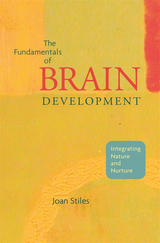 The Fundamentals of Brain Development: Integrating Nature and Nurture
Joan Stiles
Harvard University Press, 2008 In a remarkable synthesis of the research of the last two decades, a leading developmental neuroscientist provides psychologists with a sophisticated introduction to the brain—the system that underpins the functions that they study.
In clear terms, with ample illustrations, Joan Stiles explains the complexities of genetic variation and transcription, and the variable paths of neural development, from embryology through early childhood. She describes early developmental processes from gene expression to physiology to behavior. Sections on clinical correlations show the consequences for later physiological, neurological, or psychological disturbances in neural development.
As Stiles shows, brain development is far more complex and dynamic than is often assumed in debates about nature vs. nurture, nativism vs. cultural learning. Inherited and experienced factors interact constantly in an ever-changing organism. The key question is, what developmental processes give rise to particular structures or mechanisms?
A landmark of synthesis and interdisciplinary illumination, The Fundamentals of Brain Development will enrich discussion of developmental processes and more rigorously define the terms that are central to psychological debates.
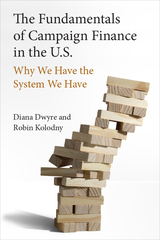 The Fundamentals of Campaign Finance in the U.S.: Why We Have the System We Have
Diana Dwyre and Robin Kolodny
University of Michigan Press, 2024 Before the U.S. campaign finance system can be fixed, we first have to understand why it has developed into the system as it exists today. The nature of democracy itself, the American capitalist economic system, the content of the U.S. Constitution and how it is interpreted, the structure of our governmental institutions, the competition for governmental power, and the behavior of campaign finance actors have all played a role in shaping the system.
The Fundamentals of Campaign Finance in the U.S. takes care to situate the campaign finance system in the context of the broader U.S. political and economic system. Dwyre and Kolodny offer readers a brief tour through the development of the campaign finance regulatory structure, highlighting the Supreme Court’s commitment to free speech over political equality from Buckley v. Valeo (1976) through the passage of the Bipartisan Campaign Reform Act (BCRA, 2002). They also examine the driving force behind campaign finance reform—corruption—through historical, transactional, and institutional perspectives. While diving into the insufficiency of the disclosure and enforcement of campaign finance laws and calling attention to multiple federal agencies, including the Securities and Exchange Commission, the Federal Communications Commission, the Internal Revenue Service, and (principally) the Federal Election Commission, the authors show how a narrow view on campaign finance makes change difficult and why reforms often have limited success. By examining the fundamentals, Dwyre and Kolodny show the difficulties of changing a political system whose candidates have always relied on private funding of campaigns to one that guarantees free speech rights while minimizing concerns of corruption.
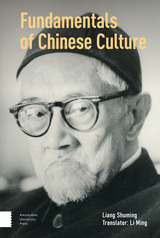 Fundamentals of Chinese Culture
Liang Shuming
Amsterdam University Press, 2021 Chinese culture, to readers of English, is somewhat veiled in mystery. Fundamentals of Chinese Culture, a classic of great insight and profundity by noted Chinese thinker, educator and social reformist Liang Shuming, takes readers on an intellectual journey into the five-thousand-year-old culture of China, the world’s oldest continuous civilization. With a set of "Chinese-style" cultural theories, the book well serves as a platform for Westerners' better understanding of the distinctive worldview of the Chinese people, who value family life and social stability, and for further mutual understanding and greater mutual consolidation among humanities scholars in different contexts, dismantling common misconceptions about China and bridging the gap between Chinese culture and Western culture. As a translation of Liang Shuming’s original text, this book pulls back the curtain to reveal to Westerners a highly complex and nuanced picture of a fascinating people.
 Fundamentals of Collection Development and Management
Peggy Johnson
American Library Association, 2018 Technical Services Quarterly declared that the third edition “must now be considered the essential textbook for collection development and management … the first place to go for reliable and informative advice." For the fourth edition expert instructor and librarian Johnson has revised and freshened this resource to ensure its timeliness and continued excellence. Each chapter offers complete coverage of one aspect of collection development and management, including numerous suggestions for further reading and narrative case studies exploring the issues. Thorough consideration is given to - traditional management topics such as organization of the collection, weeding, staffing, and policymaking;
- cooperative collection development and management;
- licenses, negotiation, contracts, maintaining productive relationships with vendors and publishers, and other important purchasing and budgeting topics;
- important issues such as the ways that changes in information delivery and access technologies continue to reshape the discipline, the evolving needs and expectations of library users, and new roles for subject specialists, all illustrated using updated examples and data; and
- marketing, liaison activities, and outreach.
As a comprehensive introduction for LIS students, a primer for experienced librarians with new collection development and management responsibilities, and a handy reference resource for practitioners as they go about their day-to-day work, the value and usefulness of this book remain unequaled.
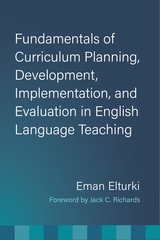 Fundamentals of Curriculum Planning, Development, Implementation, and Evaluation in English Language Teaching
Eman Elturki
University of Michigan Press, 2026 Since curriculum planning, development, implementation, and evaluation are closely interconnected, developing conceptual knowledge and practical understanding of these areas is essential for a quality curriculum. Effective curriculum practices examine the teaching and learning experience comprehensively to ensure its readiness, coherence, effectiveness, and consistency in meeting students’ needs. Fundamentals of Curriculum Planning, Development, Implementation, and Evaluation in English Language Teaching provides comprehensive knowledge and resources for English language teachers, teachers-in-training, curriculum developers, and language programs.
This book offers a systematic guide to navigating the different phases of the curriculum, from its inception to its evaluation. Part I explores the conceptual and theoretical foundations that shape curriculum and instruction. Part II provides practical knowledge and guidelines that programs and individual teachers can adopt or adapt to their specific educational contexts with the goal is to optimize the teaching and learning experience. Elturki draws largely on knowledge from the field of education, particularly curriculum studies, to complement what we know about L2 teaching and learning from Applied Linguistics, Second Language Acquisition, and English Language Teaching. Each chapter begins with pre-reading questions to stimulate thinking and concludes with post-reading questions for reflection, encouraging readers to connect the material to their own context.
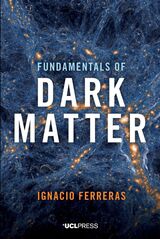 Fundamentals of Dark Matter
Ignacio Ferreras
University College London, 2025 A fundamental guide to the physics of dark matter, combining rigorous explanations with relevant exercises and questions to deepen students’ understanding.
Fundamentals of Dark Matter provides a comprehensive and accessible introduction to one of the greatest mysteries in astrophysics. Designed for advanced undergraduates and graduate students, this textbook presents the key discoveries that led to the dark matter hypothesis and also fosters critical thinking with thought-provoking “How about…?” questions in each chapter.
Ignacio Ferreras guides readers through the historical challenges in galactic astrophysics and the cosmic microwave background, outlining the evidence that has made dark matter a fundamental component of modern cosmology. The book also explores the latest developments in galaxy formation and the ongoing search for the true nature of dark matter.
Each chapter includes clear learning outcomes and discussion questions, making it an ideal resource for courses in extragalactic astrophysics or cosmology. With its engaging pedagogical approach, Fundamentals of Dark Matter equips students with both the knowledge and the curiosity to explore one of the most dynamic areas of modern astrophysics.
Fundamentals of Electromagnetic Levitation: Engineering sustainability through efficiency
Alan J. Sangster
The Institution of Engineering and Technology, 2012 Electromagnetic levitation is commonly associated with transport applications, principally 'MagLev' trains. However, the technology has many potential applications across engineering, particularly where there is a requirement to improve efficiency of electrical products and devices, propelled by the desire to minimise frictional and bearing losses and ohmic losses in conductors, which are the major causes of machine inefficiency.
Fundamentals of Electromagnetics with MATLAB®
Karl E. Lonngren
The Institution of Engineering and Technology, 2007 Fundamentals of Electromagnetics with MATLAB® Second Edition equips you for your journey into learning the theory and the application of electromagnetic fields and waves.
 Fundamentals of Electronic Resources Management
Alana Verminski
American Library Association, 2022 Recipient of the 2018 Association for Library Collections & Technical Services (ALCTS) Outstanding Publication Award Whether it's networking with vendor reps or poring over data, the continually evolving field of electronic resources management (ERM) is always throwing something new your way. Alana Verminski and Kelly Marie Blanchat were once new on the job themselves, crossing over from research instruction and the vendor side of scholarly publishing. They share what they've learned along the way in this hands-on guide. Cutting through the complexity of a role that's changing rapidly, inside you'll find to-the-point advice on methods and tools that will help you stay on top of things, including coverage of such key topics as - the full range of purchasing options, from Big Deals to unbundling to pay-per-view;
- conversation starters that will help build productive relationships with vendor reps;
- questions to ask vendors about accessibility;
- common clauses of licensing agreements and what they mean;
- understanding the four types of authentication;
- using a triage approach to troubleshooting hitches in accessing articles;
- conducting an overlap analysis to evaluate new content;
- the basic principles of usage statistics, and four ways to use COUNTER reports when evaluating renewals;
- tips for activating targets in your knowledge base;
- five steps to developing an effective marketing plan; and
- how to master the lingo, with clear explanations of jargon, important terms, and acronyms.
 Fundamentals of Ethics
John Finnis
Georgetown University Press, 1983 Are we entitled to be confident that our moral judgements can be objective? Can they express insights into aspects of reality, rather than mere feelings, tastes, desires, decisions, upbringing, or conventions? Why must we consider some of our choices to be free, and how do our free choices matter? How far should our moral judgements be based on assessments of expected consequences? Can utilitarianism, and other consequentialist or proportionalist theories, be anything more than the rationalization of positions taken on other grounds? The main theme of this book is the challenge to ethics from philosophical scepticism and from contemporary forms of consequentialism. But in seeking to meet this challenge, the book develops a sustained philosophical argument about many of the central questions of ethics. It reviews classical positions, and challenges some long-influential interpretations of those positions. It also reviews and participates in some recent developments and controversies in Anglo-American ethical theory. The activity of ethical theorizing itself is shown to be a matter of free and intelligent decision, in pursuit of intelligible good; it thus provides a test-case for any ethical theory.
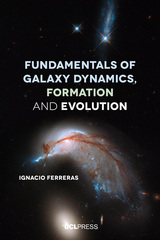 Fundamentals of Galaxy Dynamics, Formation and Evolution
Ignacio Ferreras
University College London, 2019 Galaxies, along with their underlying dark matter halos, constitute the building blocks of the universe. Of all the fundamental forces, gravity is the dominant one that drives the evolution of structures from small density seeds to the galaxies we see today. The interactions among myriads of stars, or dark matter particles, in a gravity-based structure produce a system with fascinating implications for thermodynamics, including both similarities and fundamental differences. Ignacio Ferreras presents a concise introduction to extragalactic astrophysics, with an emphasis on stellar dynamics and the growth of density fluctuations in an expanding universe. Additional chapters are devoted to smaller systems (stellar clusters) and larger ones (galaxy clusters). Written for advanced undergraduates and beginning postgraduate students, Fundamentals of Galaxy Dynamics provides a useful tool to embark on a research career. Some of the derivations for the most important results are presented in detail to enable students to appreciate the beauty of math as a tool to understand the workings of galaxies. Each chapter includes a set of problems to help students advance with the material.
Fundamentals of Ground Radar for Air Traffic Control Engineers and Technicians
Ronald D. Bouwman
The Institution of Engineering and Technology, 2009 This is a standard reference for FAA and military air traffic control engineers and maintenance technicians focused on ground-based radar systems. With the evolution and increasing sophistication of modern radar systems, now more than ever a single-source reference is needed that contains simply understandable information on MTI, MTD, and Air Traffic Control Radar Beacon systems. There is a downside to the drive away from knowledge-based problem solving...massive increases in costs and waste inherent in the idea of lowest replaceable units. Fewer technicians are expected to manage more systems while knowing less about their equipment. This unique training and reference text will not only provide answers for day-to-day tasks, it will also help allay cost increases and waste.
Fundamentals of Inertial Navigation Systems and Aiding
Michael Braasch
The Institution of Engineering and Technology, 2022 The aim of this book is to provide an advanced introduction to inertial data processing (determination of attitude, velocity and position) along with design architectures and algorithms used to aid the inertial navigation system (INS). The emphasis is on the high-end sensors and systems used in aerospace applications (known as 'navigation grade' or 'nav grade').
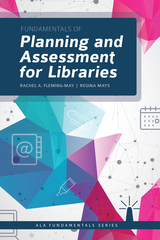 Fundamentals of Planning and Assessment for Libraries
Rachel A. Fleming-May and Regina Mays
American Library Association, 2021 The concepts of planning and assessment are intrinsically linked—and understanding them is essential for raising the library’s profile and strengthening its position among stakeholders and the community. Even if you're an LIS student or are new to the profession, or if planning or assessment are not your primary areas of responsibility, you still have a role to play in the success of organizational efforts. Fleming-May has more than a decade of experience in planning and assessment initiatives and instruction, and Mays was her institution’s first assessment librarian; their primer draws from theory, research, and their first-hand observations to illuminate such topics as - characteristics of bad planning strategy that can help to illustrate a better approach;
- reasons why using economic models, like ROI, fall short;
- how to mix the three types of planning;
- guidelines to ensure that assessment is meaningful and actionable;
- tips for creating effective surveys;
- emphasizing users’ needs with a critical assessment framework;
- data analysis for surveys, interviews, focus groups, and observation;
- four questions to ask about audience level before you develop a report;
- a sample 3-year assessment plan that can be customized; and
- seven steps for developing a culture of ongoing assessment.
 Fundamentals of Statistics
Truman Lee Kelley
Harvard University Press This book provides a broad general survey of the principles of scientific method, and a substantial basic knowledge of statistics particularly in its application to scientific research and with special relevance to the fields of the social and biological sciences. The introductory chapters aim to place statistical procedures in the reader’s general philosophy and experience, and to show him their logical importance and practical utility. Mr. Kelley then develops a detailed presentation of essential statistics. Finally, he makes a serious but admittedly initial attempt to release the niceties of middle and advanced mathematics to the peculiar problems that may be found in a given issue and with given data. His book will be of particular value in the teaching of elementary statistics in that it provides a broad scientific and logical approach. Yet, while its earlier chapters constitute a complete first semester course and the later chapters a reference handbook for one going no further, these later chapters also provide the basic topics, procedures and formulas for incorporation into second and third semester courses in applied statistics.
 Fundamentals of Sustainable Dwellings
Avi Friedman
Island Press, 2012 Despite a prolonged slump in the housing market, the demand for residential green building remains strong. More than ever, professionals need reliable information about how to construct or retrofit livable, sustainable, and economical homes. With Fundamentals of Sustainable Dwellings, Avi Friedman provides that resource. While other books on residential green building are often either superficial or overly technical, Friedman gets it just right, delivering an illustrated, accessible guide for architects, developers, home builders, codes officials, and students of architecture and green design.
Friedman charts a new course for residential building—one in which social, cultural, economic, and environmental values are part of every design decision. The book begins with a concise overview of green building principles, covering topics such as sustainable resources and common certification methods. Each following chapter examines a critical aspect of green home construction, from siting to waste management options. Friedman provides basics about energy-efficient windows and heating and cooling systems. And he offers innovative solutions like edible landscaping and green roofs.
Friedman knows that in green building, ideas are only as good as their execution. So in each chapter valuable data is assembled and a contemporary project in which designers strove to achieve sustainability while adhering to real-world constraints is featured. The result is a practical guide for every professional in the burgeoning field of residential green building.
Fundamentals of Systems Engineering for Defense Systems Applications
Thomas W. Jeffrey
The Institution of Engineering and Technology, 2017 Fundamentals of Systems Engineering for Defense Systems Applications is a user guide to systems engineering with an emphasis on applications in the defence sector and a practical approach based on putting the theory and tools to work in real-life situations.
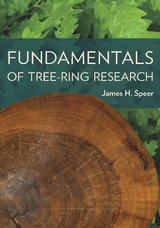 Fundamentals of Tree Ring Research
James H. Speer
University of Arizona Press, 2010 Tree-ring dating (dendrochronology) is a method of scientific dating based on the analysis of tree-ring growth patterns. As author James Speer notes, trees are remarkable bioindicators. Although there are other scientific means of dating climatic and environmental events, dendrochronology provides the most reliable of all paleorecords. Dendrochronology can be applied to very old trees to provide long-term records of past temperature, rainfall, fire, insect outbreaks, landslides, hurricanes, and ice storms—to name only a few events.
This comprehensive text addresses all of the subjects that a reader who is new to the field will need to know and will be a welcome reference for practitioners at all levels. It includes a history of the discipline, biological and ecological background, principles of the field, basic scientific information on the structure and growth of trees, the complete range of dendrochronology methods, and a full description of each of the relevant subdisciplines.
Individual chapters address the composition of wood, methods of field and laboratory study, dendroarchaeology, dendroclimatology, dendroecology, dendrogeomorphology, and dendrochemistry. The book also provides thorough introductions to common computer programs and methods of statistical analysis. In the final chapter, the author describes “frontiers in dendrochronology,” with an eye toward future directions in the field. He concludes with several useful appendixes, including a listing of tree and shrub species that have been used successfully by dendrochronologists. Throughout, photographs and illustrations visually represent the state of knowledge in the field.
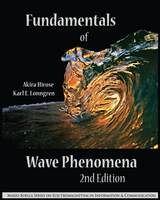 Fundamentals of Wave Phenomena
Akira Hirose
The Institution of Engineering and Technology, 2010 This textbook is written for use in any university course related to the physics of waves, wave theory, and electromagnetic waves in departments such as Physics, Electrical Engineering, Mechanical Engineering, Civil Engineering, and Mathematics. The only prerequisite knowledge is a course in calculus. This textbook provides a unified treatment of waves that either occur naturally or can be excited and propagated in various media. This includes both longitudinal and transverse waves. The book covers both mechanical and electrical waves, which are normally covered separately due to their differences in physical phenomena. This text focuses more on the similarities of all waves, mechanical orelectromagnetic, and therefore allows the reader to formulate a unified understanding of wave phenomena in its totality. This second edition contains extensive updates and advances in the understanding of wave phenomena since the publication of the first edition (1985). Numerous additional problems are now present and several chapters have been rewritten and combined. This is the first book in the Mario Boella Series on Electromagnetism in Information and Communication. Key features include: A unified treatment of wave phenomena; Numerical techniques using MATLAB; Both mechanical and electrical waves are described; Necessary mathematics required to understand the material summarized within; Only prerequisite is an introductory course in calculus.
 Fundamentals of World Organization
Werner Levi
University of Minnesota Press, 1950
Fundamentals of World Organization was first published in 1950. Minnesota Archive Editions uses digital technology to make long-unavailable books once again accessible, and are published unaltered from the original University of Minnesota Press editions.
This book offers fresh insight into the possibility of one peaceful world. It stresses pragmatic realities; it does not rest on formulation of the ideal.
Anti-democratic forces can be prevented from controlling the future course of world events only if plans are made now for a realistic world organization. The plans must be based on recognition and knowledge of all the problems involved.
Dr. Levi's approach to the broad subject of world organization is analytical, in contrast to most previous studies, which have been historical or descriptive.
With the calm, dispassionate viewpoint of a social scientist, the author upsets such common fallacies as the belief that world tension is caused primarily by clashes of ideologies or that world public opinion is effective in shaping the foreign policies of nations.
Fundamentos y modelos del estudio pragmático y sociopragmático del español
Susana de los Heros and Mercedes Niño-Murcia, Editors
Georgetown University Press, 2012 This rich textbook provides a comprehensive introduction to the principal concepts and thematic areas of Spanish pragmatics. It is aimed at advanced students of Spanish—upper-level undergraduates and beginning graduate students—who need to hone their language skills for contextually sensitive use of the language. Written entirely in Spanish, with Spanish examples, this volume introduces basic pragmatics, methods of analysis, and new thematic areas such as language and the press and globalization. Theoretical explanations combine with practical exercises in each chapter to help students master the subtleties of language use.
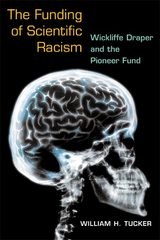 The Funding of Scientific Racism: Wickliffe Draper and the Pioneer Fund
William H. Tucker
University of Illinois Press, 2001 The Pioneer Fund, established in 1937 by Wickliffe Preston Draper, is one of the most controversial nonprofit organizations in the United States. Long suspected of misusing social science to fuel the politics of oppression, the fund has specialized in supporting research that seeks to prove the genetic and intellectual inferiority of blacks while denying its ties to any political agenda.This powerful and provocative volume proves that the Pioneer Fund has indeed been the primary source for scientific racism. Revealing a lengthy history of concerted and clandestine activities and interests, The Funding of Scientific Racism examines for the first time archival correspondence that incriminates the fund's major players, including Draper, recently deceased president Harry F. Weyher, and others.Divulging evidence of the Pioneer Fund's political motivations, William H. Tucker links Draper to a Klansman's crusade to repatriate blacks in the 1930s. Subsequent directors and grantees are implicated in their support of campaigns organized in the 1960s to reverse the Brown decision, prevent passage of the Civil Rights Act, and implement a system of racially segregated private schools.Tucker shows that these and other projects have been officially sponsored by the Pioneer Fund or surreptitiously supervised by its directors. This evidence demonstrates that any results of genuine, scientific value produced with the fund's support have been a salutary, if incidental, consequence of its actual purpose: to provide ammunition for what has essentially been a lobbying campaign to prevent the full participation of blacks in society and the polity.
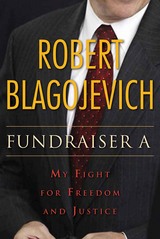 Fundraiser A: My Fight for Freedom and Justice
Robert Blagojevich
Northern Illinois University Press, 2015 Most people will recognize the name Robert Blagojevich as the brother of ill-fated Illinois governor Rod Blagojevich. But many don’t know why Robert came to work for his brother or how he came to be named as a defendant in the criminal trial accusing Rod of attempting to sell Barack Obama’s former Senate seat to the highest bidder after the presidential election of 2008. Now, Robert offers a brutally honest inside look at what it is like to face the full force and power of the federal government and maintain innocence in a high-profile criminal case.
By the time United States of America vs. Rod Blagojevich and Robert Blagojevich was over, one of the most renowned prosecutors in America, Patrick Fitzgerald, had brought down a governor of Illinois for the second time in five years. An investigation that would unseat one of the unindicted “co-conspirators” in the case, Congressman Jesse Jackson Jr., had begun. And the integrity of President Obama, US Senator Roland Burris, and Chicago Mayor Rahm Emanuel had been called into question.
For the last four months of 2008, Robert was, at his brother’s request, the head of Rod’s fundraising operation, Friends of Blagojevich. Rod and Robert had taken very different career paths and had drifted apart by middle age. But when Rod asked Robert to help him fundraise—because he couldn’t trust anyone else in the role—Robert agreed, honoring his parents’ wish that the brothers help one another when needed. In the rough-and-tumble world of Chicago-style politics, operating on an ethical level was not easy, as this telling memoir demonstrates. Robert often had to tell potential donors that there was no quid pro quo for a contribution: giving money did not result in state contracts and certainly didn’t result in an appointment to fill a vacant Senate seat.
Fundraiser A is a criminal defendant’s gripping account of how he rose to the biggest challenge of his life and beat the odds of a 96 percent Department of Justice conviction rate to walk away with his freedom. It offers not only a previously untold story of a fascinating trial with well-known, colorful characters that captured the attention of the nation, but also a look at a universal relationship—brothers—as well as the theme of a David ordinary citizen facing the Goliath federal government. Those who enjoy legal thrillers, political dramas, family sagas, and all things Chicago will be especially interested in this memoir.
Fundraising When Times Are Bad: A Guide for Nonprofit Leaders
Jeremy Beer
American Philanthropic, 2020 How do successful nonprofits raise funds when economic times are hard? How do you raise money when the rules of social engagement have changed dramatically? Jeremy Beer and the consultants at American Philanthropic tackle these urgent questions in Fundraising When Times Are Bad: A Guide for Nonprofit Leaders.
Drawing from their experience working and speaking with hundreds of nonprofit organizations and leaders, Beer and his colleagues share concrete, practical, and detailed advice related to every major area of fundraising, from direct response to events to major gifts to capital campaigns. Whether you are a nonprofit board member, CEO, advancement director, or a development officer, this timely book will help orient your fundraising efforts during today's turbulent times.
Funeral Orations
Saint Gregory Nazianzen
Catholic University of America Press, 1953 No description available
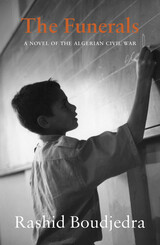 The Funerals: A Novel of the Algerian Civil War
Rashid Boudjedra
Haus Publishing, 2015 Algiers, 1955. It is in the midst of civil war, and we meet Sarah, who joins an anti-terrorism unit. There, she meets Salim, a forensic scientist. They embark on a passionate affair, facing the horror of terrorist attacks alongside their own wild impulses. Together, they learn who is to blame for the carnage at a local school. The perpetrators are the same people who tore an eleven-year-old girl from her class before beating, raping, and killing her. The assassins even dare to attend the funeral of a boy shot in the school’s courtyard while he was cleaning the blackboard. But as Sarah and Salim discover, none in the community are willing to speak out or denounce the killers, as doing so would only put their own lives at risk.
Full of suspense and drama, The Funerals takes readers behind the madness of civil war and shows how in times like these, some might attack their victims to feel a little less alone—perhaps even a little more human.
 Funga Obscura: Photo Journeys Among Fungi
Alison Pouliot
University of Chicago Press, 2025 An unforgettable visual journey through the kingdom of fungi, both enigmatic and entrancing. Recyclers, creators of soil, enablers of life, and food for many—fungi are as dynamic as they are diverse. And, throughout her career, Alison Pouliot has observed these organisms with a unique vision. As a scientist and photographer, she has led hundreds of forays through the forests of the Americas, Australia, and Europe. In this book, readers can travel along with her on these global explorations through stunning photographs and meditations on the landscape. She says her camera is where fungal lives come most clearly into focus. And like the camera obscura, this book, Funga Obscura, captures brief mycological moments and unforgettable fungus microcosms. The word funga refers to the fungi of a region, and Pouliot’s photography spans continents. We see a parade of violet webcap mushrooms, spotted in the understory of a Pacific Northwest forest; brilliantly blue pixie’s parasols in Australia; an Italian alpine lichen, looking for all the world like a treasure map; and a showstopping whitelaced shank, ready to spread its spores in Switzerland. We learn that fungi live almost everywhere, from our lawns to forests and woodlands, from the ocean’s depths to deserts and alpine peaks. Yet, like a web of rootlike mycelium, Funga Obscura goes deeper to investigate how fungi shape landscapes and interact with other organisms, including humans. This journey spans eons, from long ago in evolutionary time, when fungi first emerged from the ocean onto land, to today, when we witness their work all around us. The scenes here challenge our ideas about what fungi are, what they do, and why they matter. In Pouliot’s photographs, you might recognize a few old friends, but many mushrooms will be new acquaintances. Sometimes they make their presence immediately known; at other times, they just provide clues—and trails to follow.
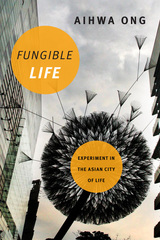 Fungible Life: Experiment in the Asian City of Life
Aihwa Ong
Duke University Press, 2016 In Fungible Life Aihwa Ong explores the dynamic world of cutting-edge bioscience research, offering critical insights into the complex ways Asian bioscientific worlds and cosmopolitan sciences are entangled in a tropical environment brimming with the threat of emergent diseases. At biomedical centers in Singapore and China scientists map genetic variants, disease risks, and biomarkers, mobilizing ethnicized "Asian" bodies and health data for genomic research. Their differentiation between Chinese, Indian, and Malay DNA makes fungible Singapore's ethnic-stratified databases that come to "represent" majority populations in Asia. By deploying genomic science as a public good, researchers reconfigure the relationships between objects, peoples, and spaces, thus rendering "Asia" itself as a shifting entity. In Ong's analysis, Asia emerges as a richly layered mode of entanglements, where the population's genetic pasts, anxieties and hopes, shared genetic weaknesses, and embattled genetic futures intersect. Furthermore, her illustration of the contrasting methods and goals of the Biopolis biomedical center in Singapore and BGI Genomics in China raises questions about the future direction of cosmopolitan science in Asia and beyond.
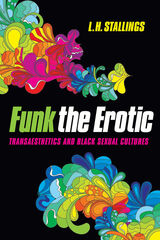 Funk the Erotic: Transaesthetics and Black Sexual Cultures
L.H. Stallings
University of Illinois Press, 2015 Funk. It is multisensory and multidimensional philosophy used in conjunction with the erotic, eroticism, and black erotica. It is the affect that shapes film, performance, sound, food, technology, drugs, energy, time, and the seeds of revolutionary ideas for black movements. But funk is also an experience to feel, to hear, to touch and taste, and in Funk the Erotic, L. H. Stallings uses funk in all its iterations as an innovation in black studies. Stallings uses funk to highlight the importance of the erotic and eroticism in Black cultural and political movements, debunking "the truth of sex" and its histories. Brandishing funk as a theoretical tool, Stallings argues that Western theories of the erotic fail as universally applicable terms or philosophies, and thus lack utility in discussions of black bodies, subjects, and culture. In considering the Victorian concept of freak in black funk, Stallings proposes that black artists across all media have fashioned a tradition that embraces the superfreak, sexual guerrilla, sexual magic, mama's porn, black trans narratives, and sex work in a post-human subject position. Their goal: to ensure survival and evolution in a world that exploits black bodies in capitalist endeavors, imperialism, and colonization. Revitalizing and wide-ranging, Funk the Erotic offers a needed examination of black sexual cultures, a discursive evolution of black ideas about eroticism, a critique of work society, a reexamination of love, and an articulation of the body in black movements.
 Funnier: A New Theory for the Practice of Comedy
Anne Libera
Northwestern University Press, 2026 A roadmap for understanding and creating comedy from the visionary Second City comedy director Great comedy can feel ineffable—and unlearnable. Debunking the myth that “either you are funny, or you aren’t,” Libera breaks the magic of comedy down into an innovative theory and practical toolkit. Developed over the course of thirty years as a director for The Second City and professor of comedy studies in their training center, Libera’s approach is effective across stand-up, sketch, film, and television comedy, as evidenced by her powerhouse students: Amy Poehler, Kristen Schaal, Steven Yeun, and many more of your favorites. This book starts with a way to think about comedy and then guides you through concrete strategies for making your work smarter, richer, funnier. Libera covers everything from generating material to revising and performing to fostering social connection through comedy. In the book’s final section, Libera draws from her personal life to make a profound case for why future comedy writers should consider the ethics of their art and their responsibility to their fellow human beings in the audience. Readers won’t just be funnier because of this book—they’ll be better people.
Funny
Jennifer Michael Hecht
University of Wisconsin Press, 2005 A tour de force, Funny is a masterpiece of poetic, as well as philosophic and comic, invention. It creates a musing world, where the issues are philosophical but the focus is always on people, on our most private ways of balancing our accounts. The poems are psychological; tender and humane, and somehow ruthless. This is poetry that swarms with ideas, that revels in rhythmic intricacy and literary references, but is also clear as a bell, and tells marvelous stories.
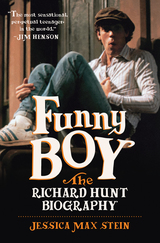 Funny Boy: The Richard Hunt Biography
Jessica Max Stein
Rutgers University Press, 2024 "The most sensational, perpetual teenager in the world.” —Jim Henson "To know him was to love him, and we do." —Mark Hamill
Funny Boy: The Richard Hunt Biography tells the life story of a gifted performer whose gleeful irreverence, sharp wit and generous spirit inspired millions. Richard Hunt was one of the original main five performers in the Muppet troupe. He brought to life an impressive range of characters on The Muppet Show, Sesame Street, Fraggle Rock and various Muppet movies, everyone from eager gofer Scooter to elderly heckler Statler, groovy girl Janice to freaked-out lab helper Beaker, even early versions of Miss Piggy and Elmo. Hunt also acted, directed and mentored the next generation of performers. His accomplishments are all the more remarkable in that he crammed them all into only 40 years.
Richard Hunt was just 18 years old when he joined Jim Henson’s company, where his edgy humor quickly helped launch the Muppets into international stardom. Hunt lived large, savoring life’s delights, amassing a vivid, disparate community of friends. Even when the AIDS epidemic wrought its devastation, claiming the love of Hunt’s life and threatening his own life, he showed an extraordinary sense of resilience, openness and joy. Hunt’s story exemplifies how to follow your passion, foster your talents, adapt to life’s surprises, genuinely connect with everyone from glitzy celebrities to gruff cab drivers – and have a hell of a lot of fun along the way.
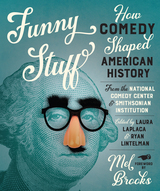 Funny Stuff: How Comedy Shaped American History
Laura LaPlaca
Rutgers University Press, 2026 The Smithsonian Institution and the National Comedy Center hold unparalleled collections of objects that illustrate the vitality and importance of comedy in American life, from 19th century vaudeville, minstrel, and puppet shows to stand-up comedians, television satire, and internet memes. Now, for the first time, these incredible collections will be shown in vibrant photographs and illuminating essays that tell the story of how comedy shaped American history.
This accessible, comprehensive history—written by historians from Smithsonian’s National Museum of American History, National Museum of African American History and Culture, and the National Comedy Center—transports readers behind the scenes to see beloved and rarely exhibited artifacts while learning the stories of famous, infamous, and unknown comics and their influence on the nation’s culture. Perfect for comedy fans, pop culture aficionados, history lovers, and anyone who has ever laughed at a viral video, this dynamic work offers a new perspective on American history and who we are as a nation through the lens of comedy.
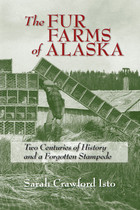 The Fur Farms of Alaska: Two Centuries of History and a Forgotten Stampede
Sarah Crawford Isto
University of Alaska Press, 2012 After its rudimentary beginning in 1749, fur farming in Alaska rose and fell for two centuries. It thrived during the 1890s and again in the 1920s, when rising fur prices caused a stampede for land and breed stock and led to hundreds of farms being started in Alaska within a few years. The Great Depression, and later the development of warm, durable, and lightweight synthetic materials during World War II, brought further decline and eventual failure to the industry as the postwar economy of Alaska turned to defense and later to oil. The Fur Farms of Alaska brings this history to life by capturing the remarkable stories of the men and women who made fur their livelihood. “For more than 200 years ‘soft gold’ brought many people to Alaska. Fur farming was Alaska’s third-largest industry in the 1920s, and Sarah Isto writes of the many efforts, successes, and ultimately of the fur farming industry’s failure. This well-researched history contextualizes current fox elimination projects on Alaska islands and explains the abandoned pens one stumbles across. This is a story that has long needed to be written.”—Joan M. Antonson, Alaska State Historian
Fur Trade and Empire: George Simpson's Journal, Revised Edition
George Simpson
Harvard University Press In 1824-25 George Simpson, governor-in-chief of the American Territories of the Hudson’s Bay Company, made a canoe voyage from Hudson Bay to the Oregon country. His journal for this time is not only a record of trade but a revelation of early nineteenth-century processes of British empire building. To the lay reader the volume brings a fascinating account of Indian life together with records of swift movement and thrilling adventure in the Indian country. A large-scale reproduction of a rare and valuable contemporary Arrowsmith map shows the immense area controlled by the Hudson’s Bay Company, the extent of exploration in it, and the division of it into districts for the purposes of the fur trade. Professor Merk introduces the volume with a brief history of the Company and a sketch of the governor.
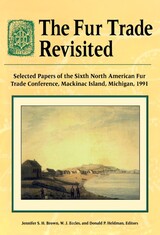 The Fur Trade Revisited: Selected Papers of the Sixth North American Fur Trade Conference, Mackinac Island, Michigan, 1991
Jo-Anne Fisk
Michigan State University Press, 1994 The Fur Trade Revisited is a collection of twenty-eight essays selected from the more than fifty presentations made at the Sixth North American Fur Trade Conference held on Mackinac Island, Michigan, in the fall of 1991. Essays contained in this important new interpretive work focus on the history, archaeology, and literature of a fascinating, growing area of scholarly investigation. Underscoring the work's multifaceted approach is an introductory essay by Lily McAuley titled "Memories of a Trapper's Daughter." This vivid and compelling account of the fur-trade life sets a level of quality for what follows. Part one of The Fur Trade Revisited discusses eighteenth-century fur trade intersections with European markets. The essays in part two examine Native people and the strategies they employed to meet demands placed on them by the market for furs. Part three examines the origins, motives, and careers of those who actually participated in the fur trade. Part four focuses attention on the indigenous fur-trade culture and subsequent archaeology in the area around Mackinac Island, Michigan, while part five contains studies focusing on the fur-trade culture in other parts of North America. Part six assesses the fur trade after 1870 and part seven contains evaluations of the critical historical and literary interpretations prevalent in fur-trade scholarship.
 Furious Cooking
Maureen Seaton
University of Iowa Press, 1996 By turns chic, romantic, sardonic, droll, seductive, and in your face, Maureen Seaton is a cornucopia of attitudes and styles, a street-smart, deeply talented woman who wryly contemplates the charades that the self and the world assume—and how hard it is to stay in focus the morning after. It gets very, very hot in Seaton's kitchen and in her poems. As this inventive and imaginative poet states, “Furious Cooking is a stew of accidents and incidents rolling across universes.” Seaton creates curious and energetic juxtapositions; she revisits violence and assesses its damages. The poet/woman in the thick of this caldron instigates polarities and assumes the roles of inquisitor and heretic, perpetrator and child, painter and artifact, scientist and specimen. She careens circularly through the hypocrisies and atrocities of church and partner, established sanctioned realities, the seeming senseless death of loved ones in this life and long ago.
 Furious Dusk
David Campos
University of Notre Dame Press, 2015 Rhina P. Espaillat, judge of the 2014 Andrés Montoya Poetry Prize, describes Furious Dusk, David Campos’s winning collection, as "a work whose five parts trace a son’s efforts—only partially successful—to fulfill his father’s expectations and—perhaps even more difficult—understand those expectations enough to forgive them.” The poet's reflections are catalyzed by learning of his father’s impending death, which, in turn, forces him to examine his father’s expectations against his own evolving concept of what it means to be a man.
The poems' speaker sifts through his past to find the speckles of memory that highlight the pressures to fit the mold of masculinity forged both by the Mexican culture of his father and the American culture he inhabits. The problematic norms of both rip the speaker in two directions as he recounts his father’s severe parenting, as he explores the inability to father a child, as he witnesses human suffering, as he overeats and confronts the effects on his body, and, finally, as he realizes what it means to transcend these expectations. The speaker’s epiphany frees him to reject masculine stereotypes and allows him to see himself simply as a human being. That realization, in turn, enables the speaker to see his father not only as “father,” “husband,” and “man,” but as a citizen of Earth. Through Campos’s bold imagery and accessible language and themes, he memorably adds to the continuing conversation of the effects of cultural expectations on the children of immigrant parents.
"This is a fearless poetics—no heroes, no myth-making, no jazzy lingo games. David Campos is intent on one inner phrase: 'I will become the fire.' I applaud David’s first book. It is relentless in wrestling the darkness, reminiscent in some ways of Delmore Schwartz, Joan Larkin, and Victor Martinez. A tour de force, a rare heart of raw light." —Juan Felipe Herrera, California Poet Laureate
“David Campos writes tenderly and with compassion about fathers, sons, and the way we become men. He writes with an original voice and fire about race, identity, and nation. He writes lyrics that skirt tightropes of impossible, beautiful contradictions. David is a Fresno poet, an American poet, a Chicano poet, and more. This is an extraordinary book of grace, I cannot recommend it highly enough.” —Chris Abani, author of Sanctificum and Hands Washing Water
“A monster debut collection that refuses to go unnoticed, the same way one cannot divert their eyes from an anatomical dissection. In five deftly crafted sections, we are given an unflinching view of the poet’s own innards; from wrestling with eating disorders to father-son relations, body image, and marriage, the tendons and ligaments of a life are exposed, and the red muscle of reality is left jutting toward you, the reader. Campos’s poetry is a physical experience, a glimmering mirror that forces us to call out our own dark secrets, to be accountable and 'take comfort that we’re alive as animals.' From the same literary stomping grounds and fertile groves that first produced the fearless and prophetic Andrés Montoya himself—emerges this new and necessary breed of luminary voice.” —Tim Z. Hernandez, author of Mañana Means Heaven
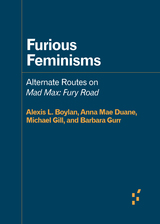 Furious Feminisms: Alternate Routes on Mad Max: Fury Road
Alexis L. Boylan
University of Minnesota Press, 2019 A provocative peek into this complicated film as a space for subversion, activism, and imaginative power While both fans and foes point to Mad Max: Fury Road’s feminist credentials, Furious Feminisms asks: is there really anything feminist or radical happening on the screen? The four authors—from backgrounds in art history, American literature, disability studies, and sociology—ask what is possible, desirable, or damaging in theorizing feminism in the contested landscape of the twenty-first century. Can we find beauty in the Anthropocene? Can power be wrested from a violent system without employing and perpetuating violence? This experiment in collaborative criticism weaves multiple threads of dialogue together to offer a fresh perspective on our current cultural moment.
Forerunners: Ideas First
Short books of thought-in-process scholarship, where intense analysis, questioning, and speculation take the lead
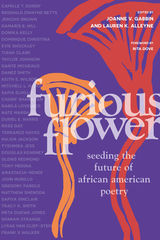 Furious Flower: Seeding the Future of African American Poetry
Edited by Joanne V. Gabbin and Lauren K. Alleyne; Foreword by Rita Dove
Northwestern University Press, 2020 Furious Flower: Seeding the Future of African American Poetry is an anthology of poems by more than one hundred award-winning poets, including Jericho Brown, Justin Philip Reed, and Tracy K. Smith, with themed essays on poetics from celebrated scholars such as Kwame Dawes, Meta DuEwa Jones, and Evie Shockley. The Furious Flower Poetry Center is the nation’s first academic center for Black poetry. In this eponymous collection, editors Joanne V. Gabbin and Lauren K. Alleyne bring together many of the paramount voices in Black poetry and poetics active today, composing an electrifying mosaic of voices, generations, and aesthetics that reveals the Black narrative in the work of twentieth- and twenty-first-century writers. Intellectually enlightening and powerfully enlivening, Furious Flower explores and celebrates the idea of the Black poetic voice by posing the question, What’s next for Black poetic expression?
Furious Harvests
Alex Averbuch
Harvard University Press Furious Harvests transports readers to Alex Averbuch’s homeland of eastern Ukraine. Amid the bloody destruction brought by Russia’s war of aggression, the poet toils in fields of memory, reaping lyrics from family archives and mementos to amass testaments to the complex and painful histories of this place and its peoples. A family tree, letters to home, and the faint scent of a grandmother’s dress kept in the back of a closet speak to histories of inter-ethnic violence, WWII forced laborers, and the Holocaust. Mixing dialects, styles, registers, and voices, Furious Harvests—presented in a bilingual edition—defiantly cries out in its rage and longing toward reconciliation of the self and other.
Furious Lullaby
Oliver de la Paz
Southern Illinois University Press, 2007 Furious Lullaby is both a celebration of and a eulogy to the body in the twenty-first century. The collection, which examines the larger concepts of salvation and temptation in a world of blossoming strife, includes a series of aubades – dramatic poems culminating with the separation of lovers at dawn. The lovers suffer a metaphysical crisis, seeking to know what is good, what is evil, and how to truly know the difference. Knowing, however, invites the terrible into their world. The Devil, a seductive trickster, haunts the landscape as a voice who dares each inquisitor to learn about mortality, morality, the beautiful, and the unspeakable through direct experience. Furious Lullaby offers a departure from the lighter prose poetry of de la Paz’s Names above Houses and preserves the author’s concern with the nature of human grace.
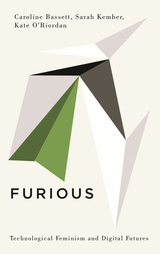 Furious: Technological Feminism and Digital Futures
Caroline Bassett
Pluto Press, 2019 As digital transformations continue to accelerate in the world, discourses of big data have come to dominate in a number of fields, from politics and economics, to media and education. But how can we really understand the digital world, ask the authors of Furious, when so much of the writing through which we grapple with it remains deeply problematic? In a compelling new work of feminist critical theory, Bassett, Kember and O'Riordan scrutinise many of the assumptions of a masculinist digital world, highlighting the tendency of digital humanities scholarship to venerate and essentialise technical forms, and to adopt gendered writing and citation practices. Contesting these writings, practices and politics, the authors foreground feminist traditions and contributions to the field, offering alternative modes of knowledge production, and a radically different, poetic writing style. Through this prism, Furious brings into focus themes including the automation of home and domestic work, the Anthropocene, and intersectional feminist technofutures.
Furs Not Mine
Andrea Cohen
Four Way Books, 2015 The poems in Furs Not Mine display Andrea Cohen’s masterful craft and lyricism and her keen wit. In Cohen’s elegiac shoals, we see how “Great griefs are antidotes / for lesser sorrows,” and in her strange, surprising narratives, we glimpse a man darting into traffic for a hubcap, “meaning to build his dream / vehicle from scrap.” These poems, too, have the feel of dreamy constructions, in which bliss “from a distance, can look like pain.” That’s the magic of this collection: it holds loss and promise in the same image—sometimes even the same word.
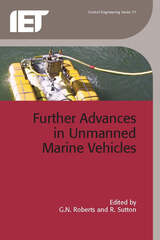 Further Advances in Unmanned Marine Vehicles
G.N. Roberts
The Institution of Engineering and Technology, 2012 The previous volume Advances in Unmanned Marine Vehicles brought together eighteen chapters describing research and developments in unmanned marine vehicles (UMVs). It was observed that almost without exception research groups worldwide were developing and working on real UMVs which means that they are able to test, evaluate and re-evaluate their designs in relatively quick succession, thereby rapidly reporting new approaches, techniques, designs and successes. This rapid design-evaluation cycle is the prime mover for progress, not only for consolidating designs but also leading to new design ideas and innovation. Since its publication in 2006, Advances in Unmanned Marine Vehicles has proven to be a useful and popular source of reference. However, the rapid design-evaluation cycle means further advances have been made which need to be reported. Thus, the seventeen chapters contained in this volume cover further advances in autonomous underwater vehicles, remotely operated vehicles, semi-submersibles, unmanned surface vessels whilst operating autonomously and/or in co-operation with other types of UMV. This book will be of interest to undergraduates, postgraduates, researchers and industrialists who are involved in the design and development of UMVs.
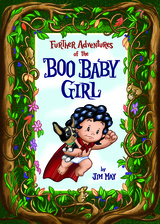 Further Adventures of the Boo Baby Girl
Jim May
Parkhurst Brothers, Inc., 2018 The Boo Baby girl tires of the boring life of a baby, crawling around, getting up, falling down, walking around the coffee table, falling down . . . she aims for more so she climbs out the window—miraculously, as soon as she is out the window she can walk, run, climb, and talk like a grownup. So she heads out to seek her fortune.
The first adventure she has is rescuing Bootsie, The Cattle-hearding Chiahuahua. Bootsie has been kicked by a cow and is bleeding. Boo has some band aids in her pack – this pack will be like Bill Lepp’s magical Swiss Army Knife, containing everything from sophisticated medical supplies, to lasers, to time machines, and, of course her pacifier, which she affectionately calls her “suckie.”
She saves Bootsie, who is bilingual. He thanks her in Spanish: “Muchas Gracias mi muchacha.” She does not understand so not only do they have adventures for the rest of the book but he teaches her some fun Spanish phrases like: NO TOQUEZ NADA (Don’t Touch!) if someone is bothering them. Their main job is to face ghosts, and monsters, demons: boogies, the boo hag, banshees, and . . .
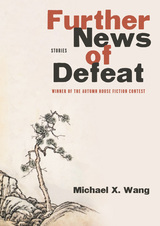 Further News of Defeat: Stories
Michael X. Wang
Autumn House Press, 2020 Steeped in a long history of violence and suffering, Michael X. Wang’s debut collection of short stories interrogates personal and political events set against the backdrop of China that are both real and perceived, imagined and speculative. Wang plunges us into the fictional Chinese village of Xinchun and beyond to explore themes of tradition, family, modernity, and immigration in a country grappling with its modern identity. Violence enters the pastoral when Chinese villagers are flung down a well by Japanese soldiers and forced to abandon their crops and families to work in the coal mines, a tugboat driver dredges up something more than garbage polluting the Suzhou River, and rural and urban landscapes are pitted against each other when young villagers are promised high-paying work in the city but face violent persecution instead. In this world where China has regressed back to its imperial days, we meet an emperor who demands total servitude and swift punishment for attempts at revolution, and we follow a father who immigrates to the United States for a better life and loses everything in a tragic accident—aside from his estranged son—with whom he stubbornly refuses to make amends. Further News of Defeat is rich with characters who have known struggle and defeat and who find themselves locked in pivotal moments of Chinese history—such as World War II and the Tiananmen Square massacre—as they face losses of the highest order and still find cause for revival. Further News of Defeat is the winner of the 2019 Autumn House Press Fiction Prize.
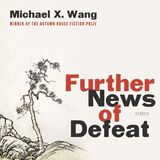 Further News of Defeat: Stories
Michael X. Wang
Autumn House Press, 2020 Steeped in a long history of violence and suffering, Michael X. Wang’s debut collection of short stories interrogates personal and political events set against the backdrop of China that are both real and perceived, imagined and speculative. Wang plunges us into the fictional Chinese village of Xinchun and beyond to explore themes of tradition, family, modernity, and immigration in a country grappling with its modern identity. Violence enters the pastoral when Chinese villagers are flung down a well by Japanese soldiers and forced to abandon their crops and families to work in the coal mines, a tugboat driver dredges up something more than garbage polluting the Suzhou River, and rural and urban landscapes are pitted against each other when young villagers are promised high-paying work in the city but face violent persecution instead. In this world where China has regressed back to its imperial days, we meet an emperor who demands total servitude and swift punishment for attempts at revolution, and we follow a father who immigrates to the United States for a better life and loses everything in a tragic accident—aside from his estranged son—with whom he stubbornly refuses to make amends. Further News of Defeat is rich with characters who have known struggle and defeat and who find themselves locked in pivotal moments of Chinese history—such as World War II and the Tiananmen Square massacre—as they face losses of the highest order and still find cause for revival. Further News of Defeat is the winner of the 2019 Autumn House Press Fiction Prize.
 Further on, Nothing: Tadeusz Kantor’s Theatre
Michal Kobialka
University of Minnesota Press, 2009 A new encounter with the work of a master of avant-garde theatre Tadeusz Kantor (1915–1990) was one of the twentieth century’s most innovative visual artists, stage directors, and theoreticians. His theatre productions and manifestos challenged the conventions of creating art in post–World War II culture and expanded the boundaries of Dada, surrealist, Constructivist, and happening theatre forms. Kantor’s most widely known productions—The Dead Class (1975), Wielopole, Wielopole (1980), Let the Artists Die (1985), and Today Is My Birthday (1990)—have had a profound impact on playwrights and artists who continue today to engage with his radical theatre. In Further on, Nothing, Michal Kobialka explores Kantor’s theatre practice from the critical perspective of current debates about representation, memory, and history. He pursues the intriguing proposition that Kantor gave material form to a theatre practice that defined the very mode of postmodern operation and that many of its theoretical notions are still in circulation. According to Kobialka, Kantor’s theatre still offers an answer to reality rather than a portrayal of a utopian alternative. Further on, Nothing includes new translations of Kantor’s work, presented in conversation with Kobialka’s own theoretical analyses, to show us a Kantor who continues to offer—and deliver on—the promise of the avant-garde.
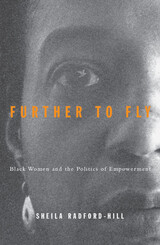 Further To Fly: Black Women and the Politics of Empowerment
Sheila Radford-Hill
University of Minnesota Press, 2000 How feminism has failed African American women and why they must fight back. Amid the longest-running economic boom in American history and despite the emergence of a significant black middle class, the lot of low-income black people in general-and black women in particular-seems more troubling than ever. Their plight, Sheila Radford-Hill argues in this book, is directly related to the diminution of black women’s traditional power as culture bearers and community builders. A cogent critique of feminist theory and practice, Further to Fly identifies the failure of feminism to connect with the social realities it should seek to explain, in particular the decline of black women’s empowerment. Further to Fly searches out the causes and effects of this decline, describing the ways in which, since the 1960s, black women have been stripped of their traditional status as agents of change in the community-and how, as a result, the black community has faltered. Radford-Hill explores the shortcomings of second-wave black and white feminism, revealing how their theoretical underpinnings have had unintended (and often unacknowledged) negative consequences for black women’s lives and their communities.While acknowledging that African American women have made significant contributions to the black struggle for justice in America, Radford-Hill argues that more needs to be done. She combines social criticism and critical analysis to argue that black women must revive their legacy of activism and reclaim the tradition of nurturing in the black community, proposing specific tactics that can be used to revive the support networks that help determine the obligations of community members and guide how people interact on an everyday level. As a deft account of genesis and effects of black women’s diminishing power, and as a sobering analysis of the devastating blunders of feminist theory and practice, this work makes a compelling argument for an "authentic feminism," one that aggressively connects the realities of women’s experiences, needs, aspirations, and responsibilities.
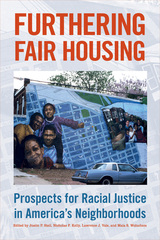 Furthering Fair Housing: Prospects for Racial Justice in America's Neighborhoods
Edited by Justin P. Steil, Nicholas F. Kelly, Lawrence J. Vale and Maia S. Woluchem
Temple University Press, 2021 The 2015 Affirmatively Furthering Fair Housing Rule was the most significant federal effort to increase equality of access to place-based resources and opportunities, such as high-performing schools or access to jobs, since the 1968 Fair Housing Act. However, in an effort to appeal to suburban voters, the Trump administration repealed the rule in 2020, leaving its future in doubt. Furthering Fair Housing analyzes multiple dimensions of this rule, identifying failures of past efforts to increase housing choice, exploring how the AFFH Rule was crafted, measuring the initial effects of the rule before its rescission, and examining its interaction with other contemporary housing issues, such as affordability, gentrification, anti-displacement, and zoning policies. The editors and contributors to this volume—a mix of civil rights advocates, policymakers, and public officials—provide critical perspectives and identify promising new directions for future policies and practices. Placing the history of fair housing in the context of the centuries-long struggle for racial equity, Furthering Fair Housing shows how this policy can be revived and enhanced to advance racial equity in America’s neighborhoods.
|
|


